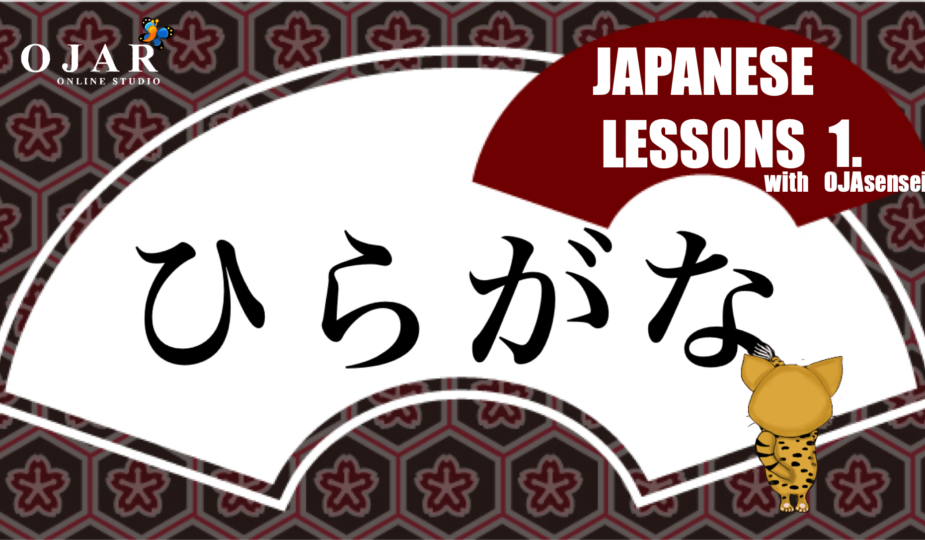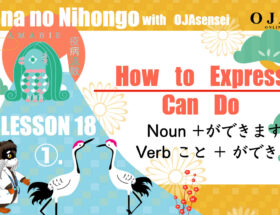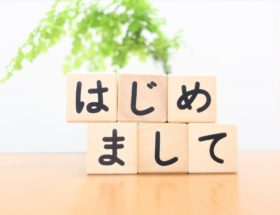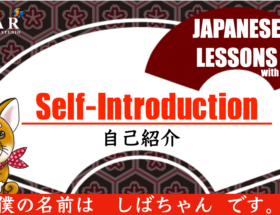こんにちは I’m ojachan 🙂 Today’s lesson is: How to write Hiranaga . Don’t you want to know how to learn Japanese like Japanese kids? This lesson is meant for students that are beginners at Japanese. We mainly express Nihongo with 3 sorts of letters and characters, ひらがな Hiragana, カタカナ Katakana, and 漢字 Kanji. You can learn how to read Hiragana, how to write Hiragana correctly and beautifully, and the history here.
Let’s get started!
Minna No Nihongo: Beginner 1, 2nd Edition (Japanese)
Customer Reviews:★★★★☆
Publisher : 3A CORPORATION; 2nd Edition (March 16, 1998)
CONTENTS
The Difference Between Japanese and Other Languages
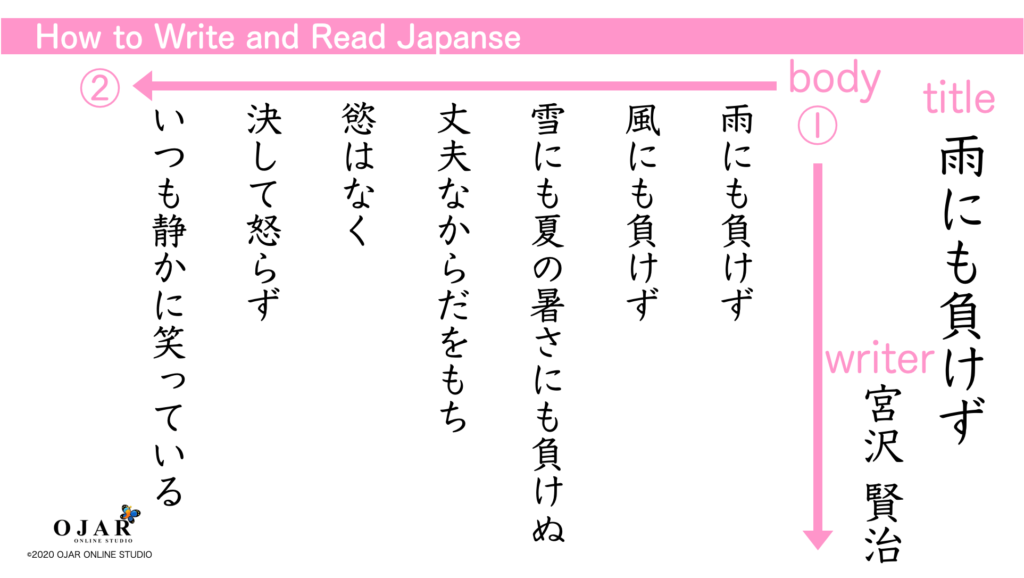
The big difference between Japanese and English is that we write Japanese “① from top to bottom” and read ” ② from right to left” against people who speaks English write it from left to right and read from top to bottom.
Almost of all Japanese literature and the books are written with this traditional style.
But we often use western style writings and books to adopt western style culture these days.
Hiragana
Hiragana is Japanese alphabet, we sometimes call it “かな文字 kana-moji” or “かな kana”.
It is said that hiragana started around 6th century to 10 century.
・How to Read Hiragana Chart
Here is “hiragana chart”. There are several type of Hiragana charts though, I recommend you to use this chart.
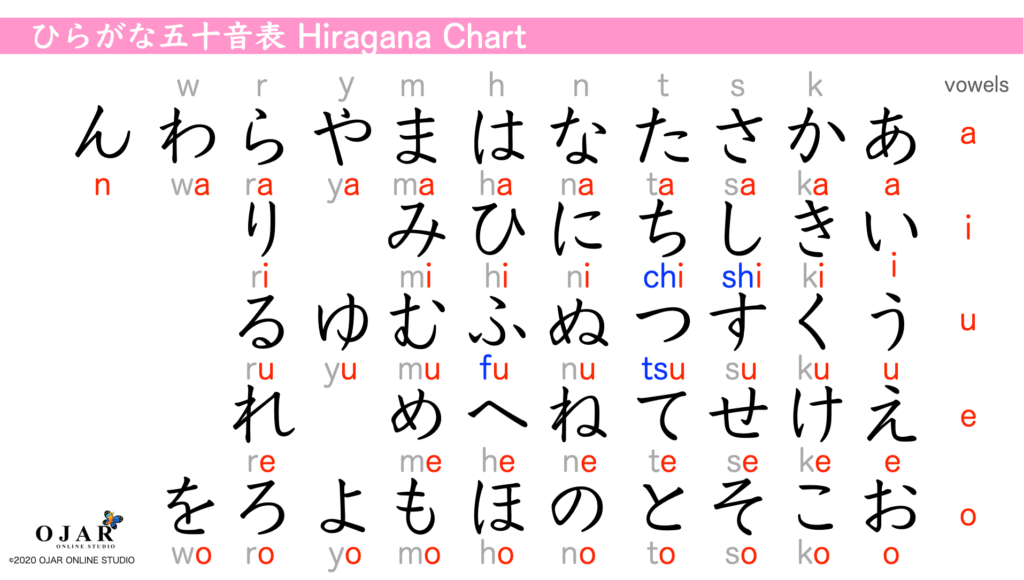
You can read from top to bottom and from right to left.
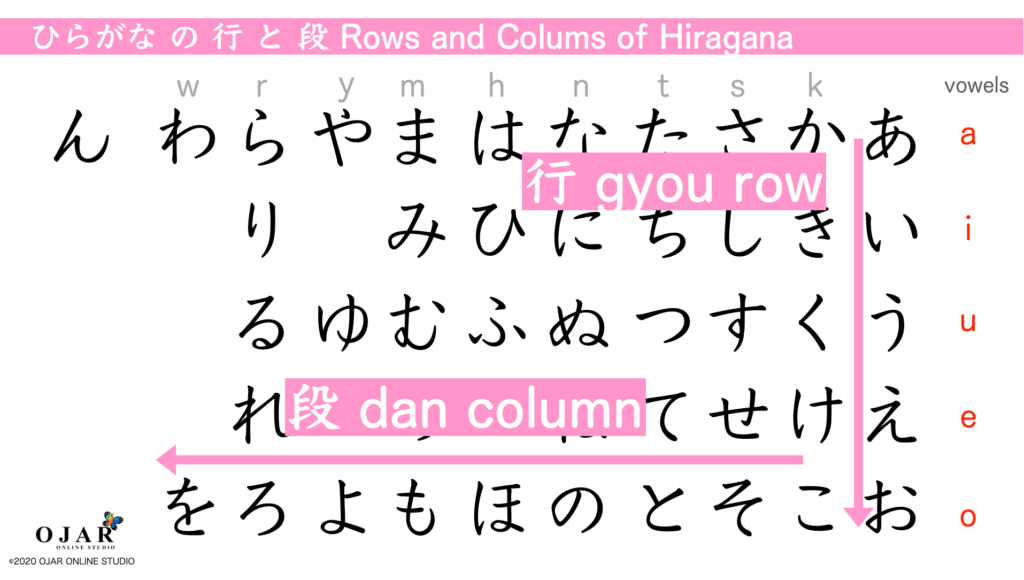
The rows are called “行 gyou” and the columns are called “段 dan”.
The first row is 5 vowel sounds the following rows are consonant unions.
・Hiragana Pronunciations
There are 46 letters, 5 vowels “ あ い う え お a i u e o”, 9 consonant-vowel unions “k- s- t- n- h- m- y- r- w-” and 1singular consonant “ん n”. we call them “ひらがな五十音 hiragana gojuu-on 50 sounds of hiragana”.
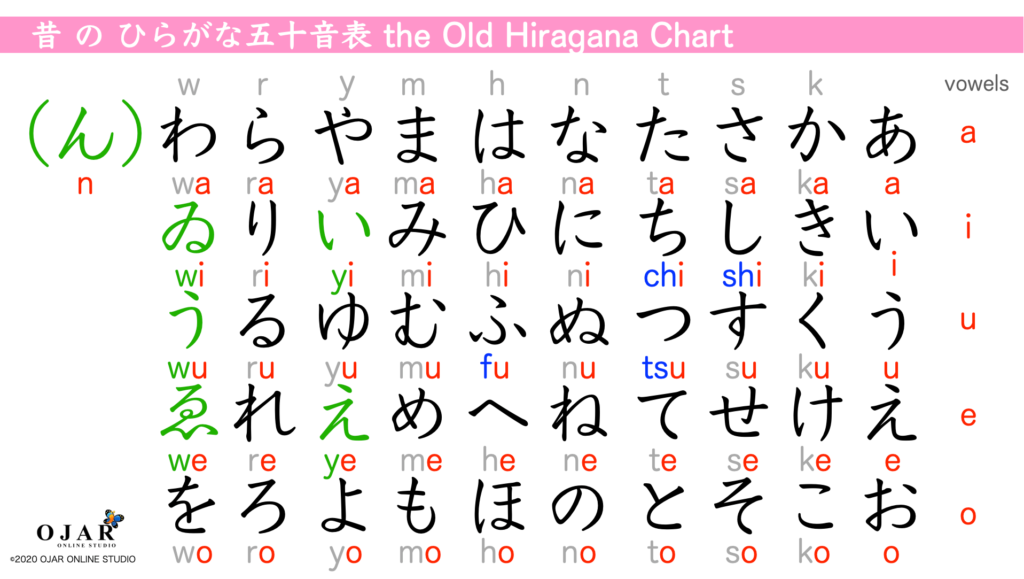
Why is it called “五十音”?
There were 50 sounds. y-sound column ( や ya い
The pronunciations are very simple and easier than other languages like English or French etc.
We usually Roman letters “ローマ字 Roma-ji”, when we express Japanese in English. There are several types of forms and this lesson is used “ヘボン式
Especially, you should be careful “し shi ち chi つ tsu ふ fu”.
And my opinion, I think らりるれろ sounds are “la li lu le lo” better than R’s sound actually when you pronounce.
・Writing Hiragana
Writing characters is difficult a little for beginner’s level of Japanese because of the keeping beautiful balance.
It is important to use graph papers till you grow your writing Hiragana skill.
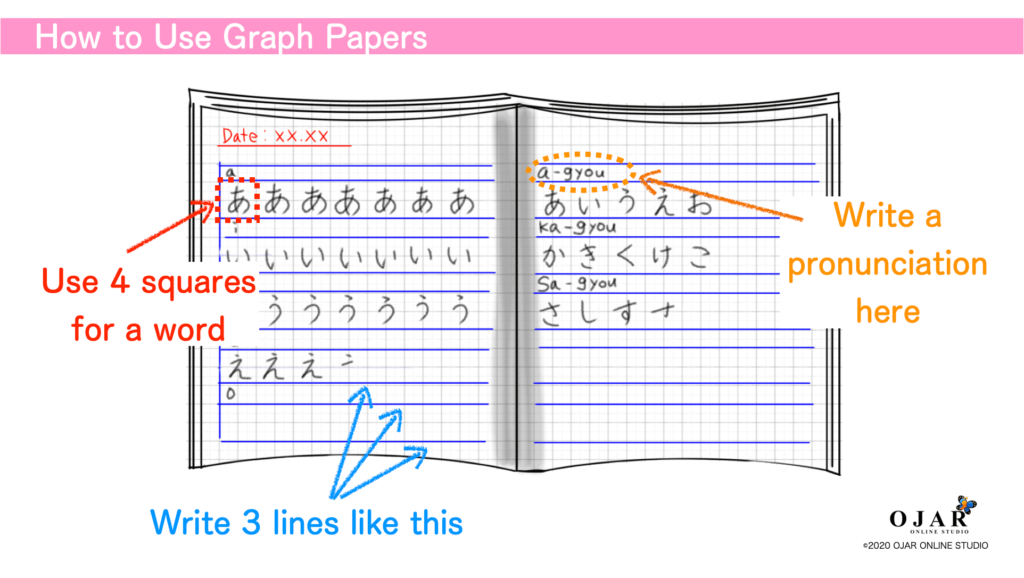
I recommend you to use graph papers till you grow your writing Hiragana skill.
You can check your Hiragana with it every time whether you could write correctly or not.
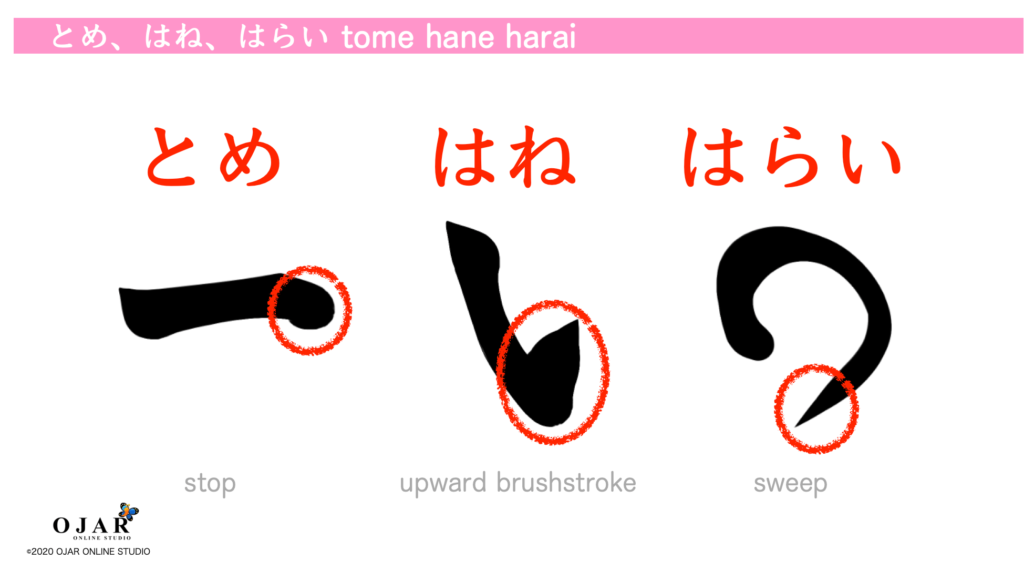
You can write beautiful Japanese when you are conscious of the writing ways, “とめ tome stop”, “はね
The reason why you learn stroke orders is that there are flows in Japanese characters. You can keep the beautiful and correct balance and memorize words easier.
Besides, sometimes it looks like the wrong character when you write it roughly. We have a lot of education for Hiragana and Kanji etc since we were a child.
Japanese people, especially elder people, often judge other personalities as seeing the person’s writing characters.
For example, the person who writes big characters must be able to have confidence in her / himself. Or the person who writes dirty characters must have a less educated or have a rough personality.
So we have cherished the writing characters very much.
And Japanese calligraphy has been boned as an art. I think performing Japanese calligraphy is similar to the conduct of an orchestra.
Don’t forget to keep the stroke orders and feel flows when you practice Hiragana characters and HAVE FUN!
■ あ行 | Hiragana a-gyou
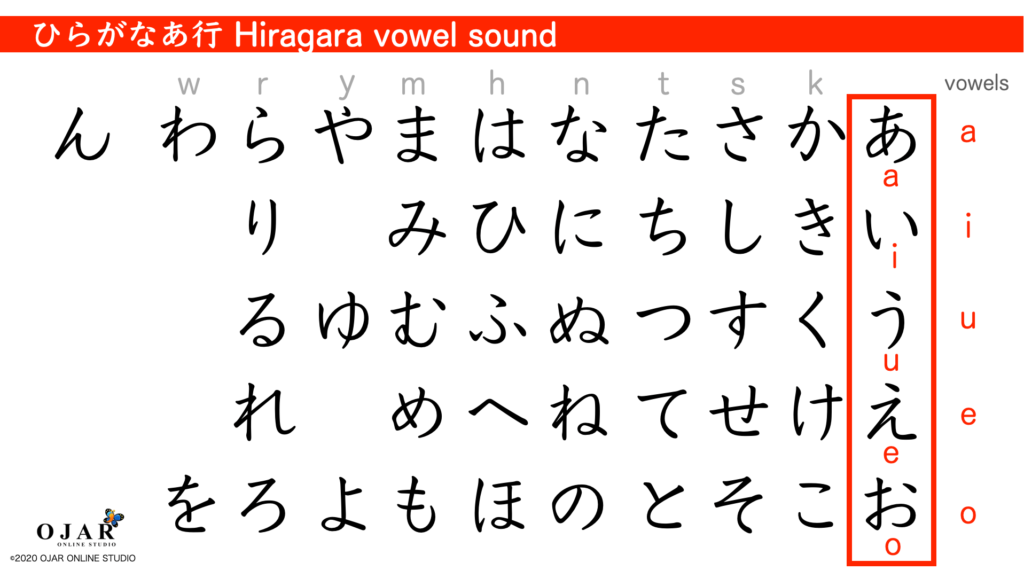
These characters create basic sounds. They are called “母音 boin vowel sounds”.
And this row is called “あ行 a-gyou”.
1. あ How to Write a
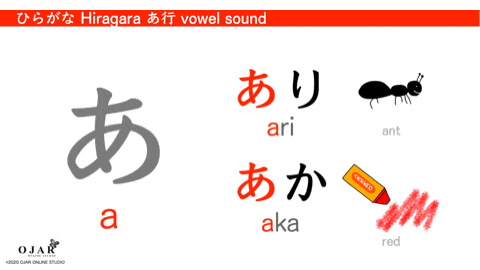
sound: a
stroke: 3
class: あ行 a-gyou
あ a” is difficult even though you learn it as the first character. You can learn “お o”, “の no”, “め me” and “ぬ nu” with this.
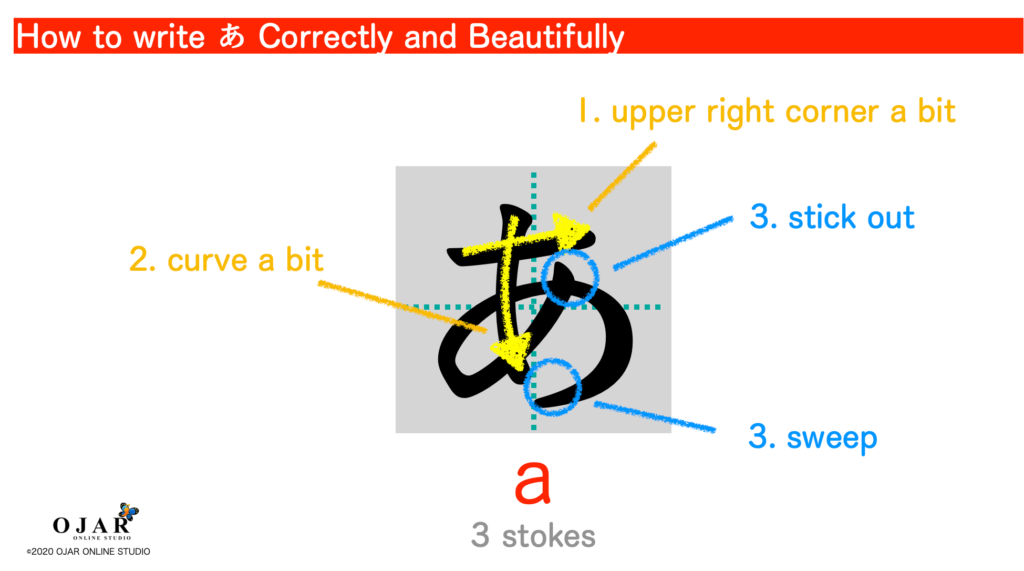
STROKE 1. Write to the upper right corner a bit.
STROKE 2. Don’t forget to stick out at the beginning. Make it curve a bit in the middle.
STROKE 3. Make it stick out a bit. Sweep at the end.
2. い How to Write i
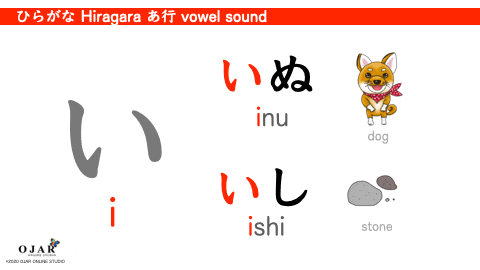
sound: i
stroke: 2
class: あ行 a-gyou
い is very simple and easy. But be careful about the balance and angles. Don’t confuse with “り
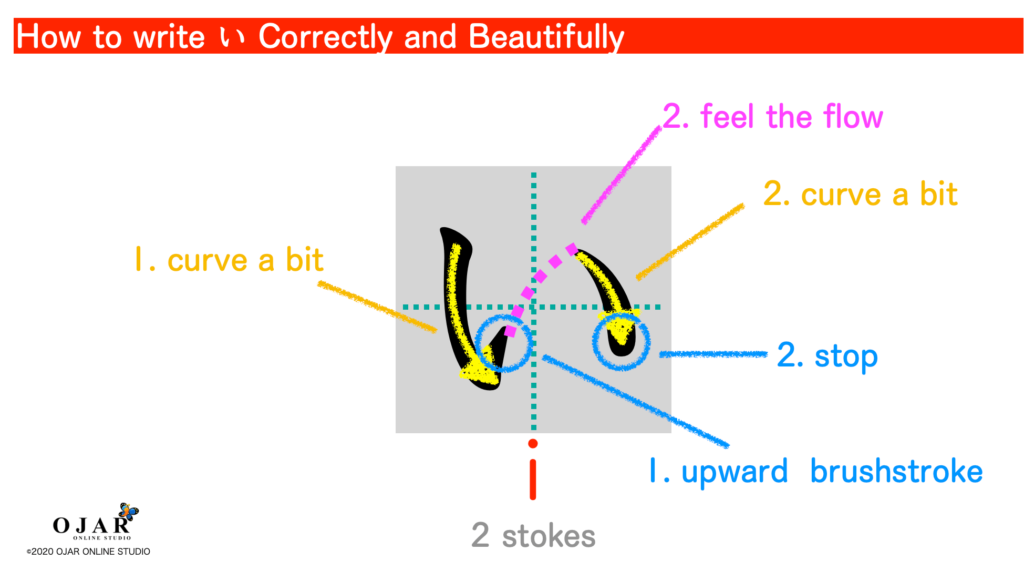
STROKE 1. Make it curve a bit in the middle. Don’t forget the upward brushstroke.
STROKE 2. Feel the flow to the 2nd stroke. Make it curve a bit in the middle. Stop at the end.
3. うHow to Write u
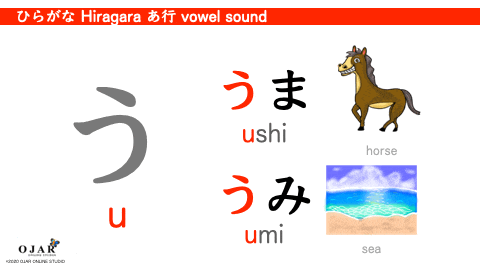
sound: u
stroke: 2
class: あ行 a-gyou
う is easy. But be careful with the balance and angles. Don’t confuse with “つ
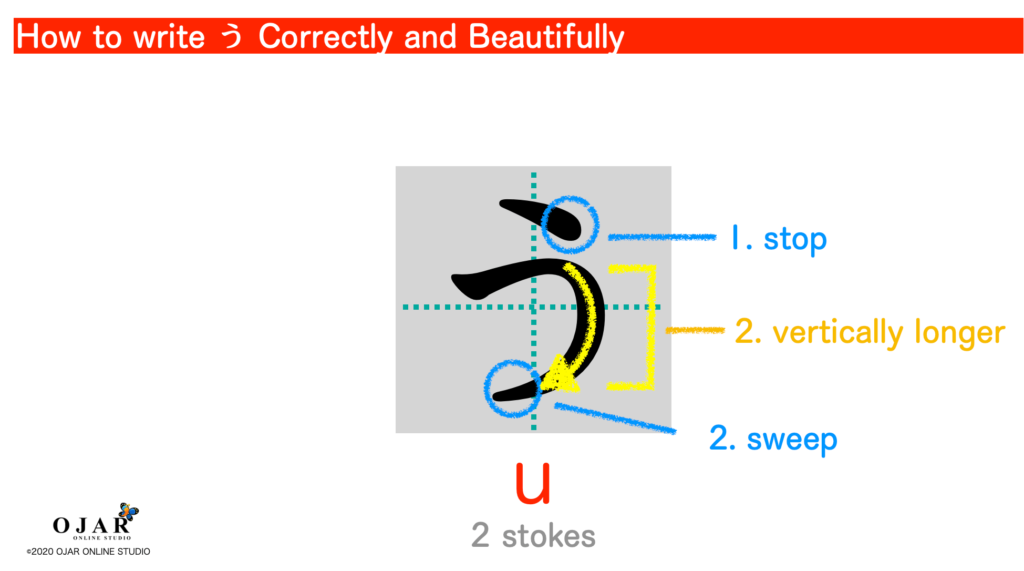
STROKE 1. Stop at the end.
STROKE 2. Write it vertically longer. Sweep at the end.
4. え How to Write e
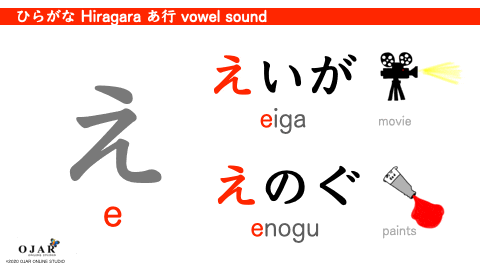
sound: e
stroke: 2
class: あ行 a-gyou
え is difficult a little. But be careful about the balance. You can learn “ね
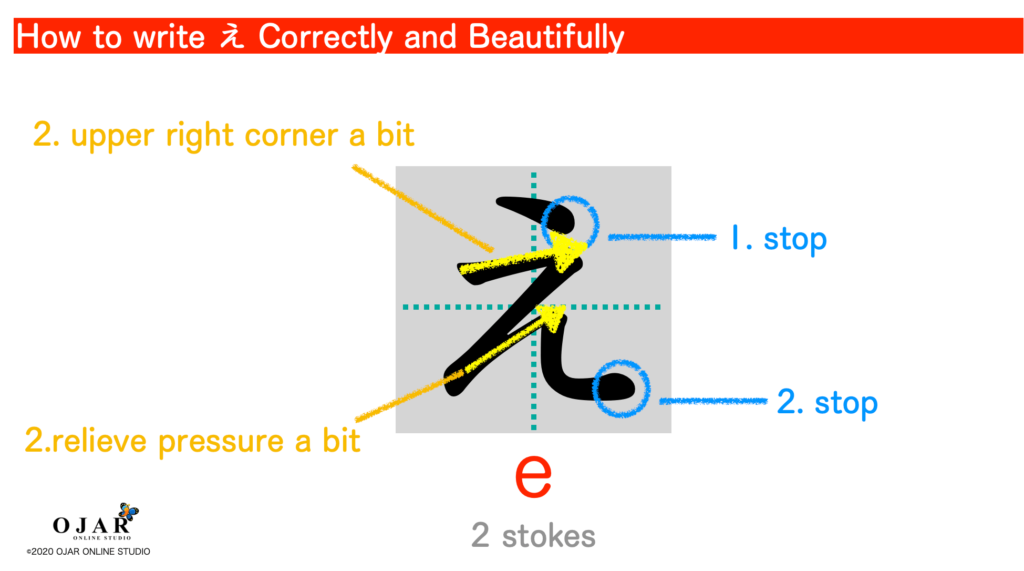
STROKE 1. Stop at the end.
STROKE 2. Write to the upper right corner a bit. Relieve pressure a bit in the middle. Stop at the end.
5. お How to Write o
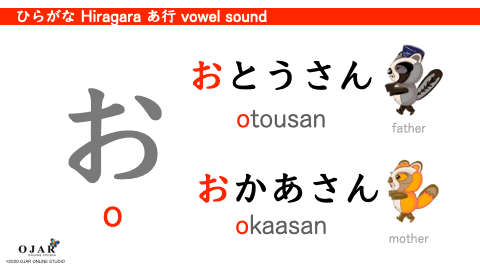
sound: o
stroke: 3
class: あ行 a-gyou
お is not difficult. But don’t confuse with “む mu”. The curving direction is the opposite. You can learn “あ a” and “の no”.
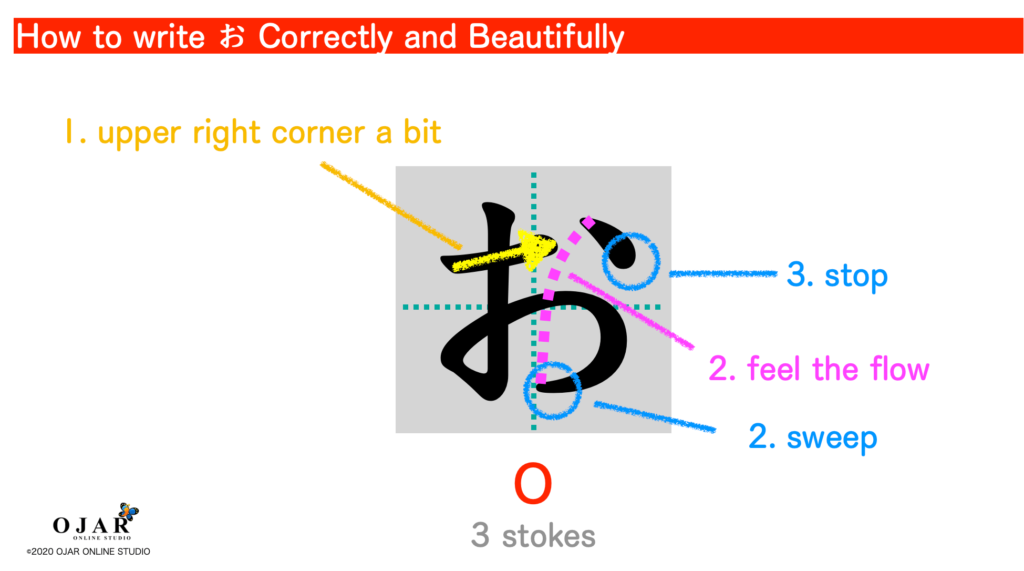
STROKE 1. Write to the upper right corner a bit.
STROKE 2. Sweep at the end. Feel the flow to the 2nd stroke.
STROKE 3. Stop at the end.
■ か行 | Hiragana ka-gyou
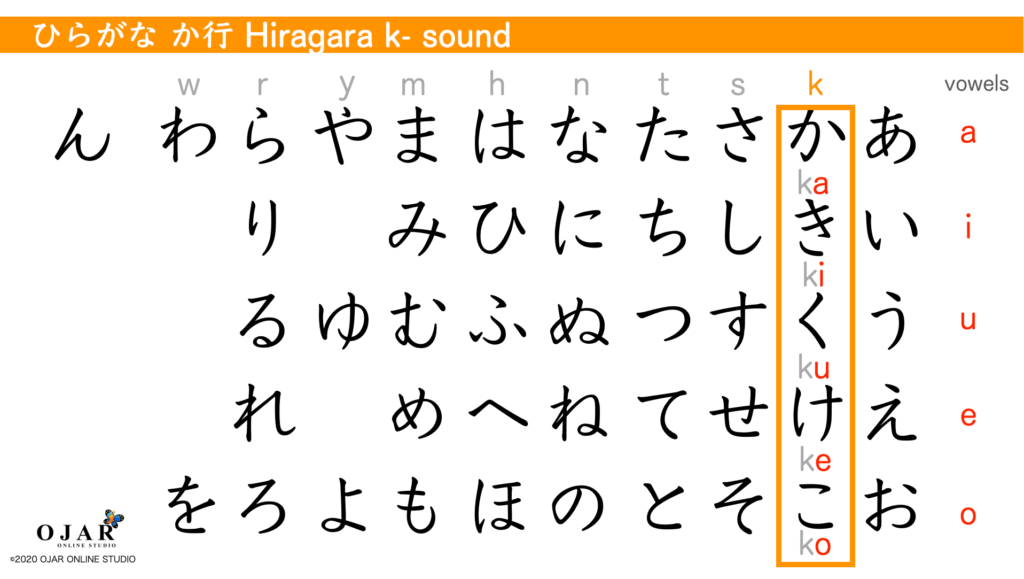
These characters create k sound of consonants and vowels. They are “か行 ka-gyou”.
6. か How to Write ka
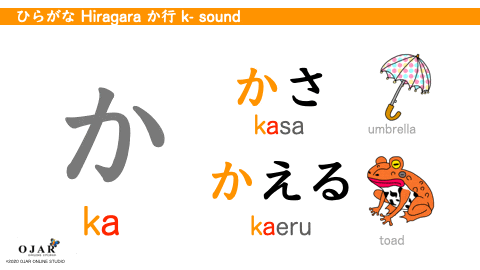
sound: ka
stroke: 3
class: か行 ka-gyou
The balance is difficult. Don’t confuse with “や ya”. The 1st stroke of か is vertically longer than “や ya”.
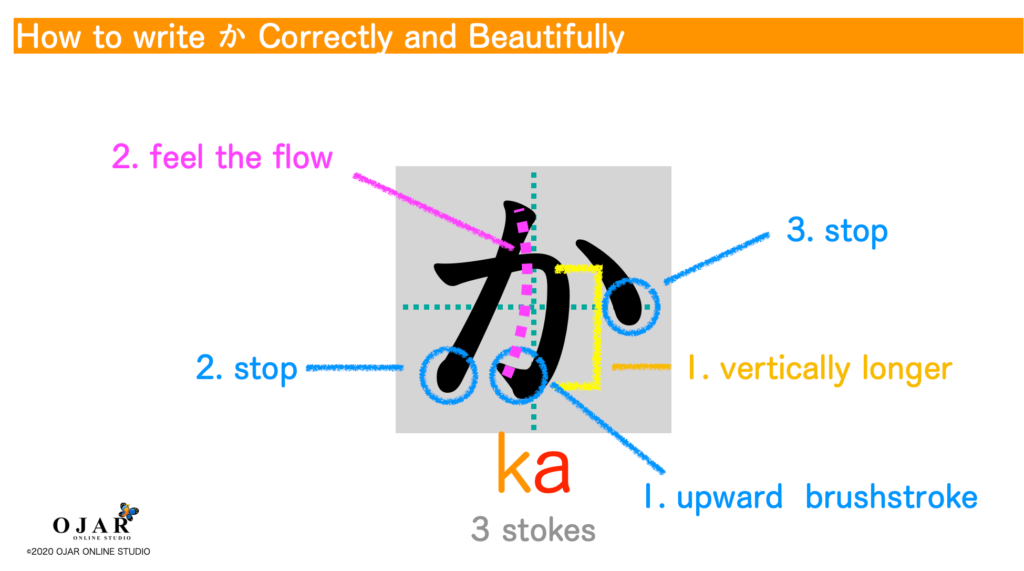
STROKE 1. Write a vertically longer line. Don’t forget the upward brushstroke.
STROKE 2. Feel the flow to the 2nd stroke. Stop at the end.
STROKE 3. Stop at the end.
7.き How to Write ki
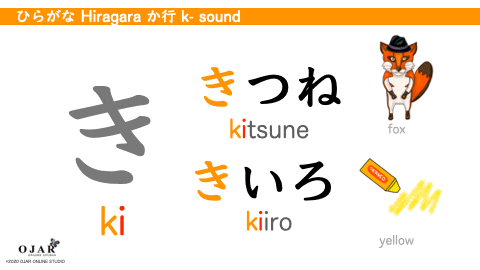
sound: ki
stroke: 4
class: か行 ka-gyou
The angle of き is important. you can learn with “さ sa”.
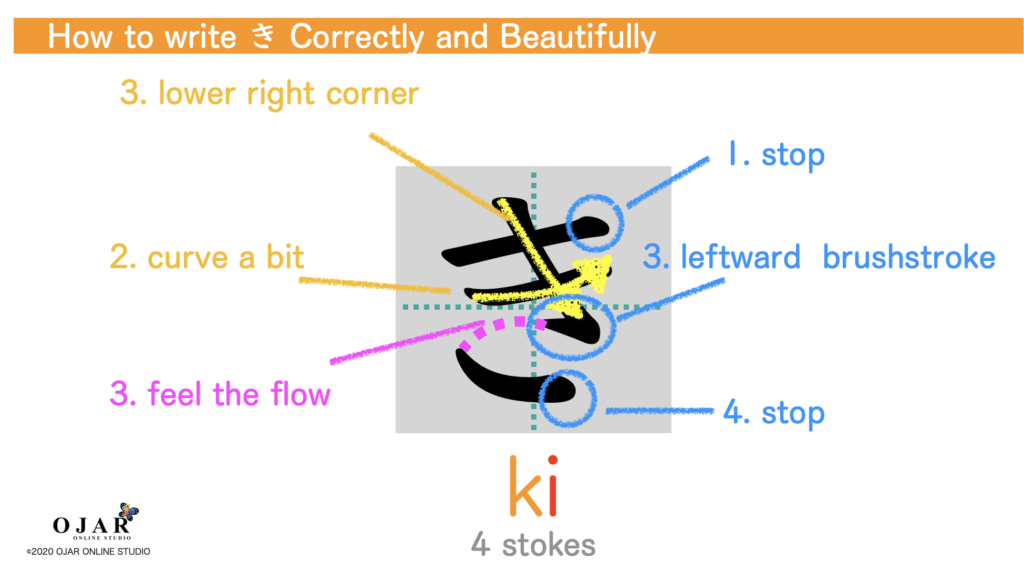
STROKE 1. Write a longer line than 2nd stroke. Stop at the end.
STROKE 2. Make it curve a bit in the middle.
STROKE 3. The angle is the most important. Make it lean to the lower right corner. Write the leftward brushstroke. Feel the flow to the 4th stroke.
STROKE 4. Stop at the end.
8.くHow to Write ku
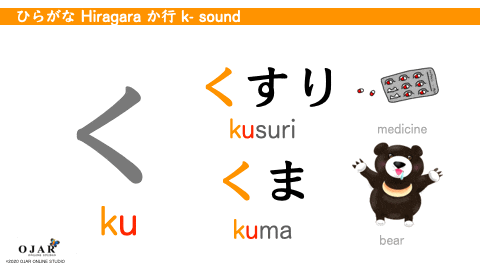
sound: ku
stroke: 1
class: か行 ka-gyou
く is very easy and simple. you can learn with “へ he”.
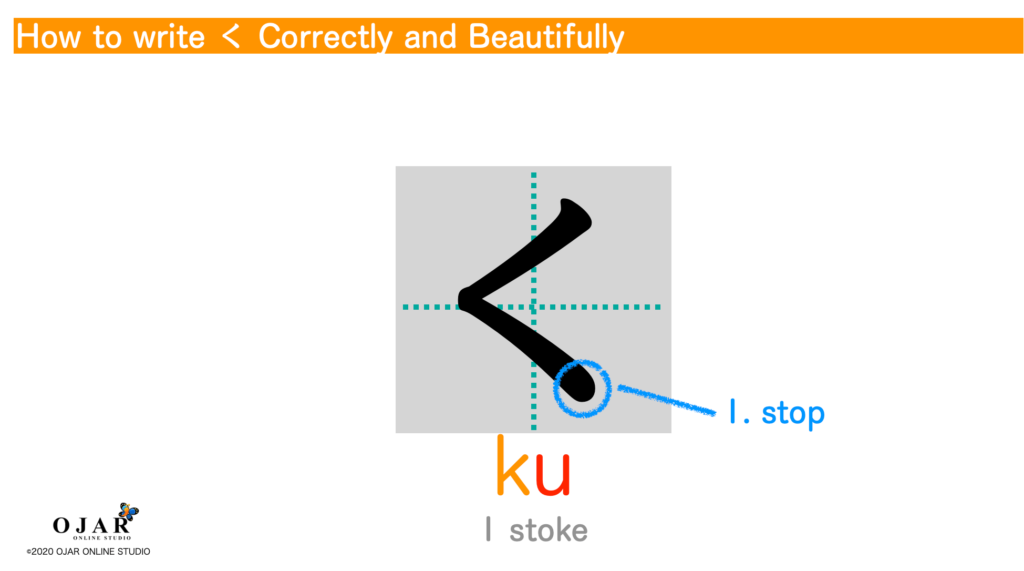
STROKE 1. Stop at the end.
9. け How to Write ke
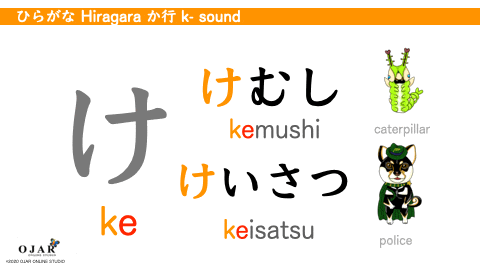
sound: ke
stroke: 3
class: か行 ka-gyou
The angle of け is difficult a bit. Don’t confuse with “さ sa”. The angle is totally different. you can learn with “は ha”.
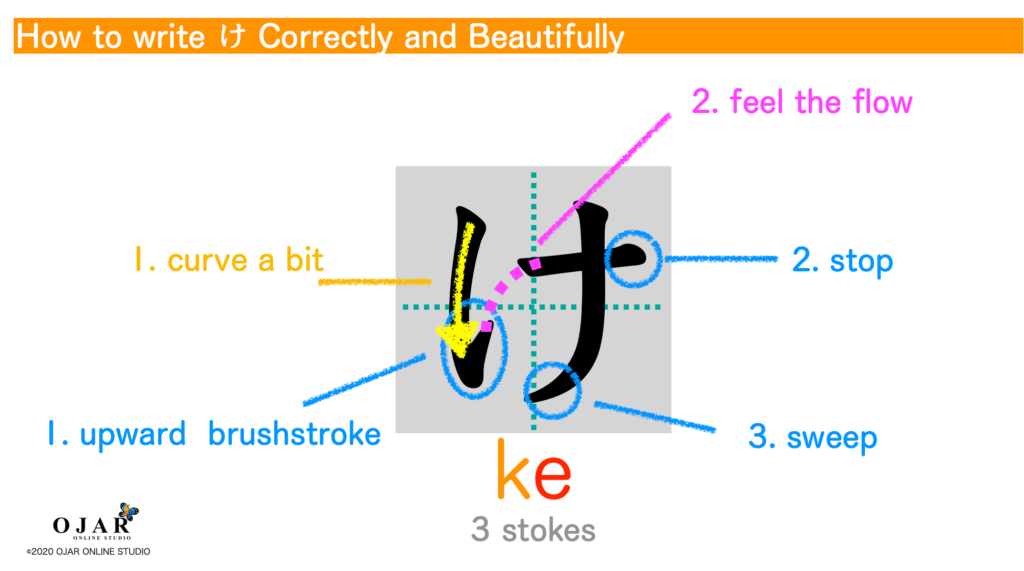
STROKE 1. Make it curve a bit and write to the downward straightly. Don’t forget the upward brushstroke.
STROKE 2. Feel the flow to the 2nd stroke. Stop at the end.
STROKE 3. Write it downward straightly. Make it sweep inside at the end.
10. こ How to Write ko
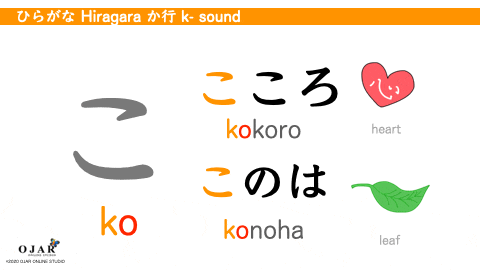
sound: ko
stroke: 2
class: か行 ka-gyou
こ is very simple and easy. you can learn with “い i”, “た ta” and “に ni”.
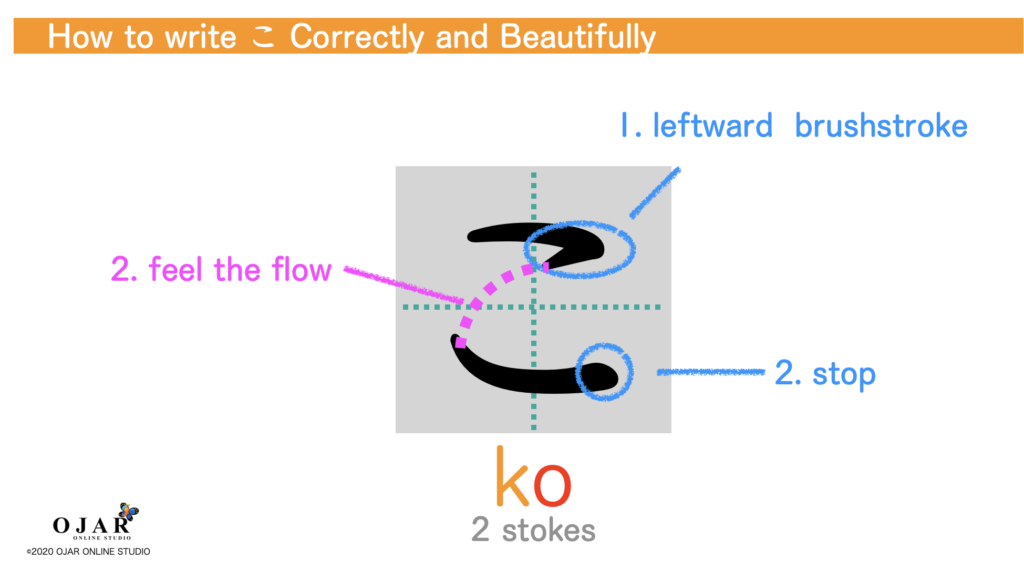
STROKE 1. Don’t forget the leftward brushstroke at the end.
STROKE 2. Feel the flow to the 2nd stroke. Stop at the end.
■ さ行 | Hiragana sa-gyou
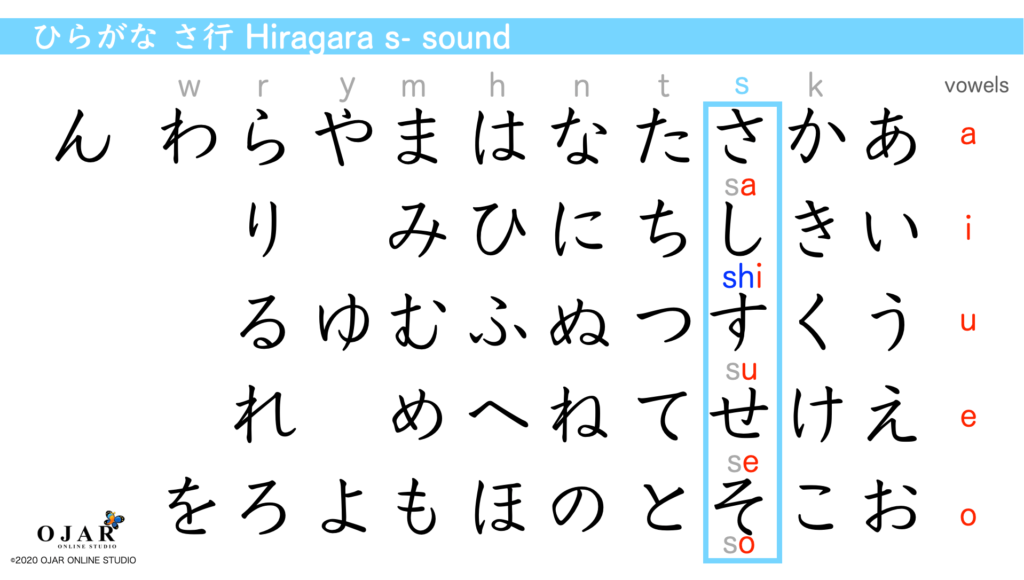
These characters create s sound of consonants and vowels. They are “さ行 sa-gyou”.
11. さ How to Write ka
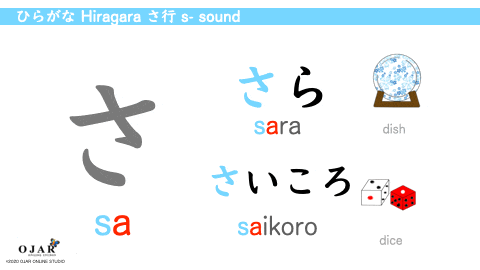
sound: sa
stroke: 3
class: さ行 sa-gyou
The angle of さ is difficult a little. Don’t confuse with “ち chi”. It’s a mirror writing against “ちchi”. You can learn with “き ki”.
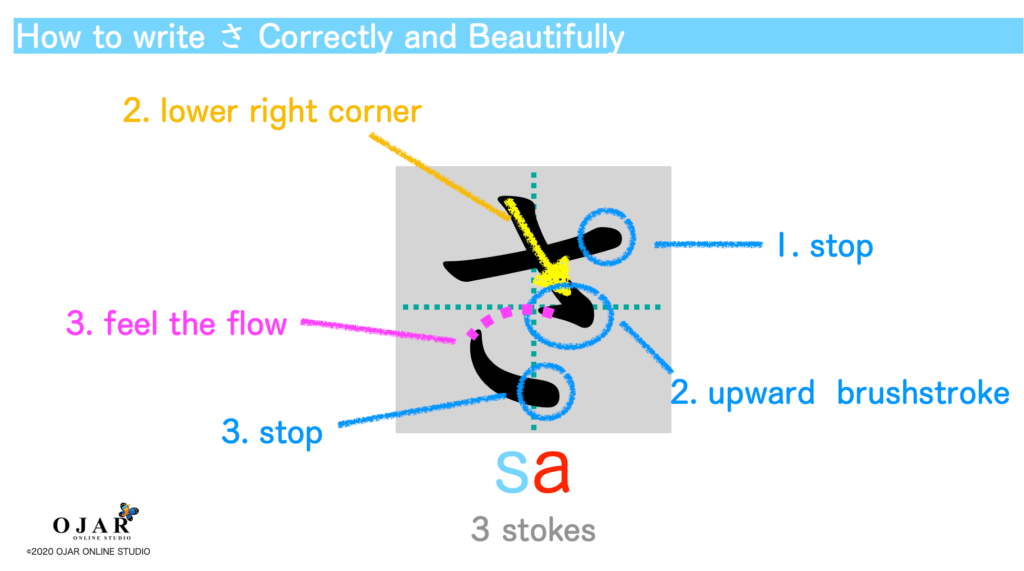
STROKE 1. Stop at the end.
STROKE 2. Write to the lower right corner a bit. Don’t forget the upward brushstroke at the end. Feel the flow to the 3rd stroke.
STROKE 3. Stop at the end.
12. し How to Write shi

sound: shi
stroke: 1
class: さ行 sa-gyou
し is very easy and simple. But be careful with the phonetic notation. It’s NOT “si”. However, you can use “si” when you type on your keyboard. You can learn with “つ
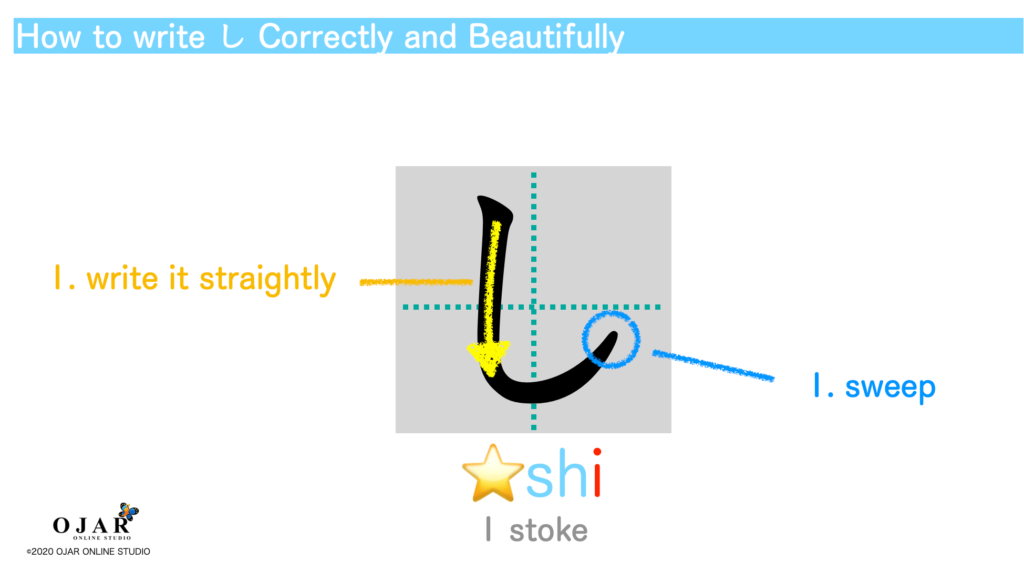
STROKE 1. Sweep outside at the end.
13. す How to Write su

sound: su
stroke: 2
class: さ行 sa-gyou
す is not difficult. You can learn with “お o”, “よ yo”, and “む mu”.
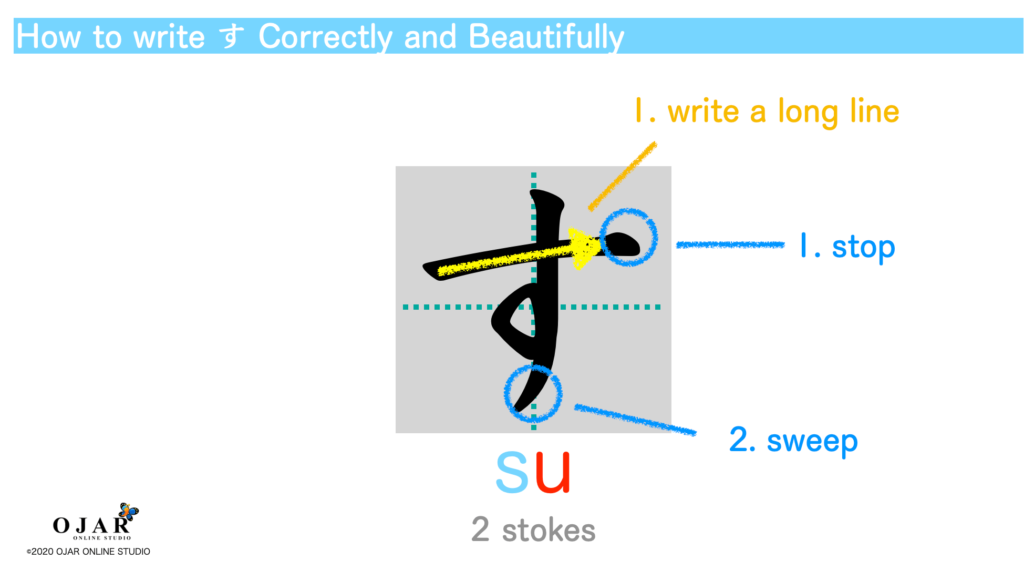
STROKE 1. Write a long line to the right. Stop at the end.
STROKE 2. Sweep at the end.
14. せ How to Write se

sound: se
stroke: 3
class: さ行 sa-gyou
The balance of せ is difficult a bit.
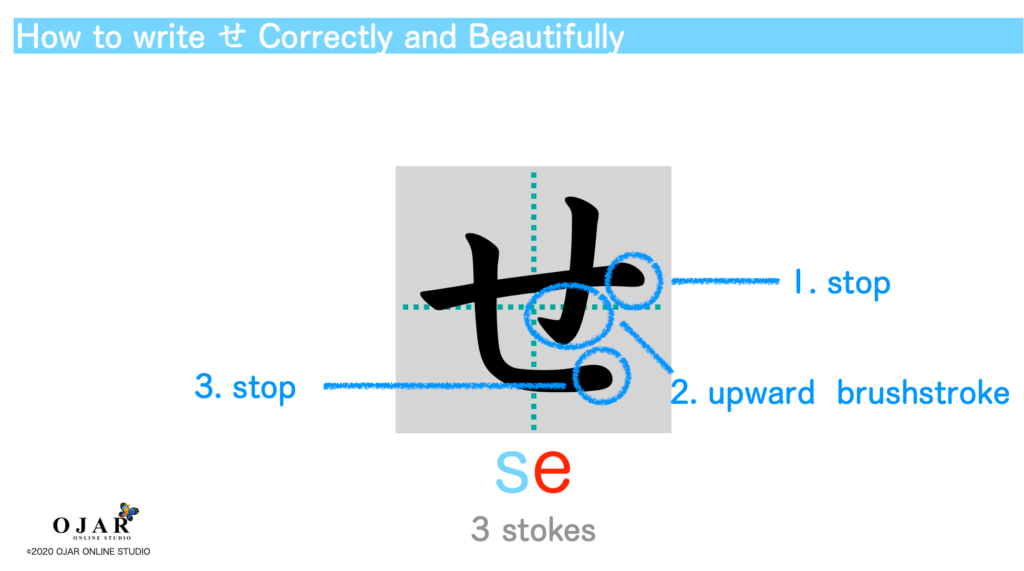
STROKE 1. Stop at the end.
STROKE 2. Write to the upward brushstroke inside.
STROKE 3. Stop at the end.
15. そ How to Write so

sound: so
stroke: 1
class: さ行 sa-gyou
The balance of “そ so” is difficult. You can learn with “て te” and “を
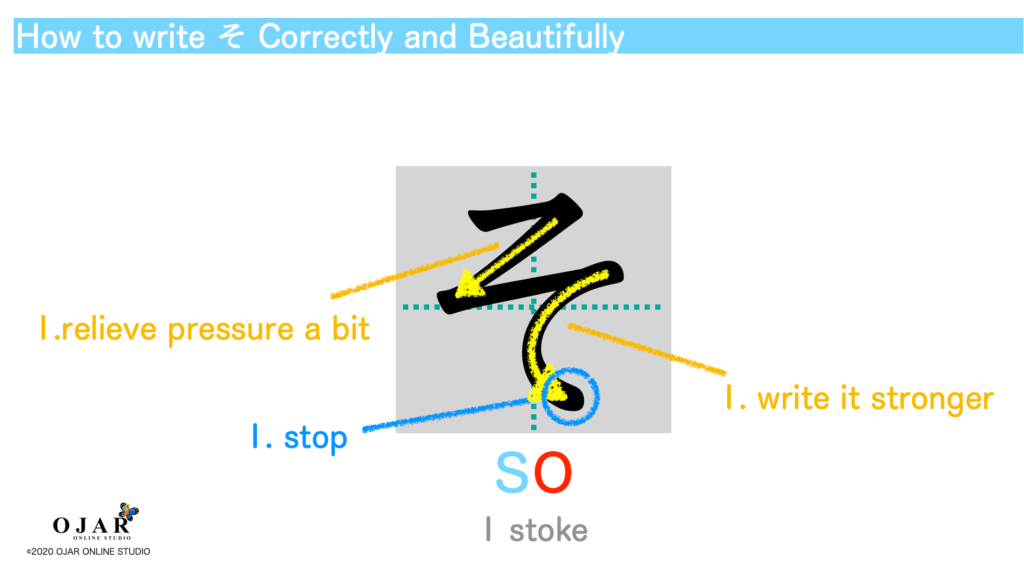
STROKE 1. Relieve pressure a bit. And write it stronger. Stop at the end.
■ た行 | Hiragana ta-gyou
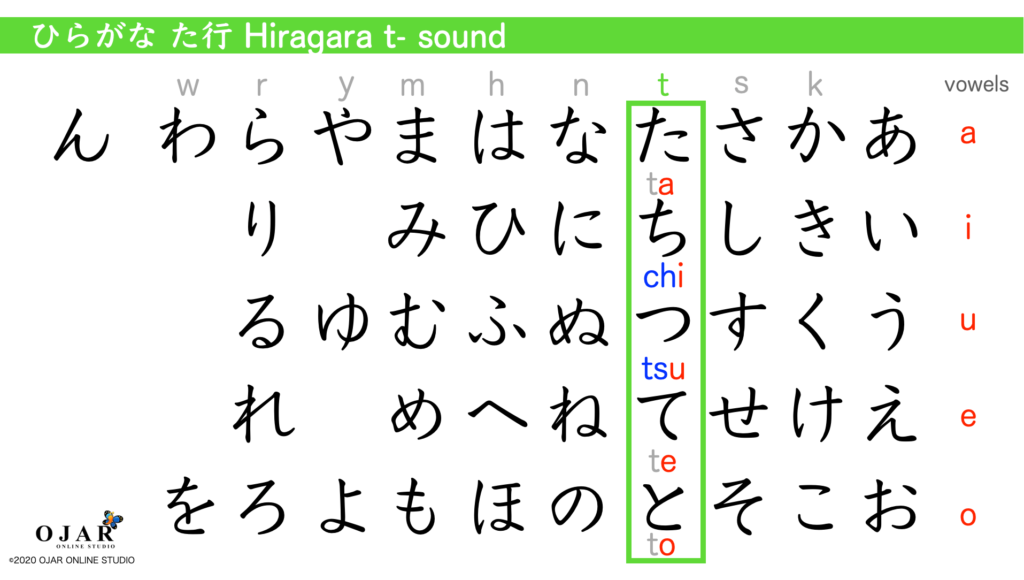
These characters create t sound of consonants and vowels. They are “た行 ta-gyou”.
16. た How to Write ta

sound: ta
stroke: 4
class: た行 ta-gyou
The balance of “た ta” is difficult. You can learn with “な na”.
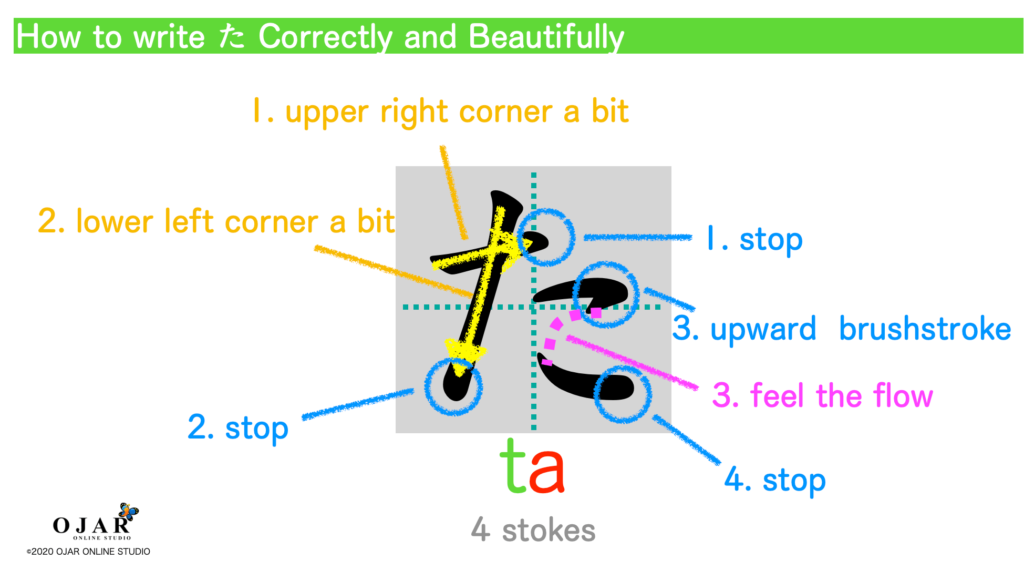
STROKE 1. Write to the upper right corner a bit. Stop at the end.
STROKE 2. Write to the left corner a bit. Stop at the end.
STROKE 3. Don’t forget the upward brushstroke at the end. And feel the flow to the 4th stroke.
STROKE 4. Stop at the end.
17.ち How to Write chi

sound: chi
stroke: 2
class: た行 ta-gyou
The angle of “ち chi” is difficult a little. Don’t confuse with “さ
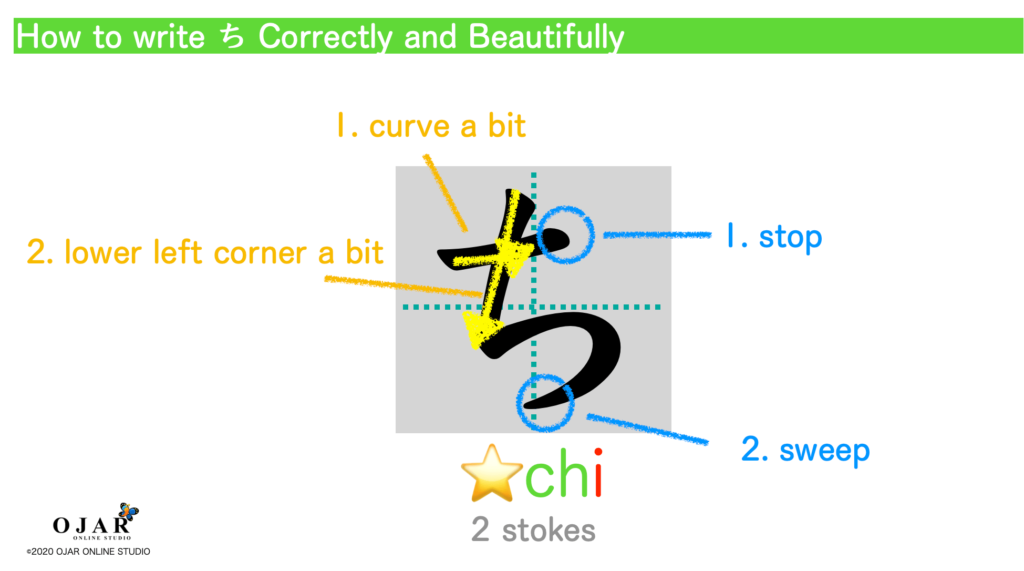
STROKE 1. Make it curve a bit. Stop at the end.
STROKE 2. Write to the left corner a bit. Sweep to the left at the end.
18. つ How to Write tsu

sound: tsu
storke: 1
class: た行 ta-gyou
し is very easy and simple. But be careful with the phonetic notation. It’s NOT “
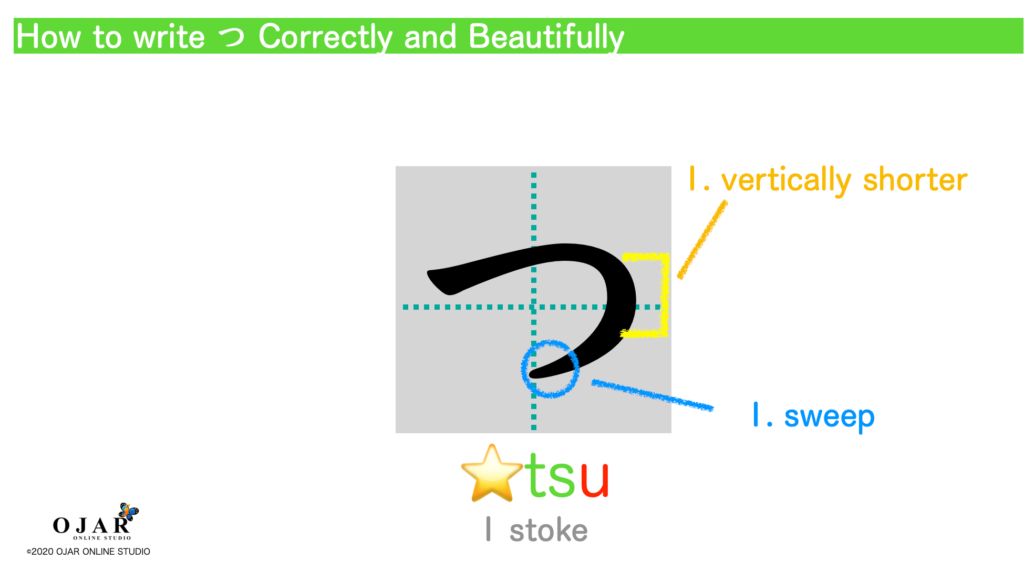
STROKE 1. Write it vertically shorter. Sweep to the inside at the end.
19. て How to Write te

sound: te
stroke: 1
class: た行 ta-gyou
て is easy and simple. You can learn with “ひ hi” and “そ so”.
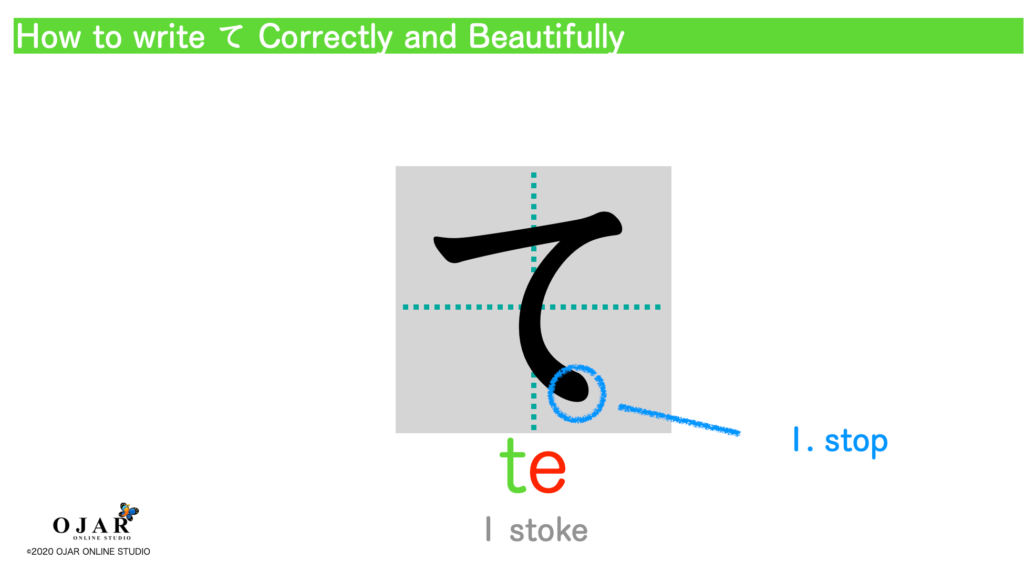
STROKE 1. Stop at the end.
20. と How to Write to

sound: to
stroke: 2
class: た行 ta-gyou
The angle of “と to” is difficult a little. You can learn with “そ so” and “を
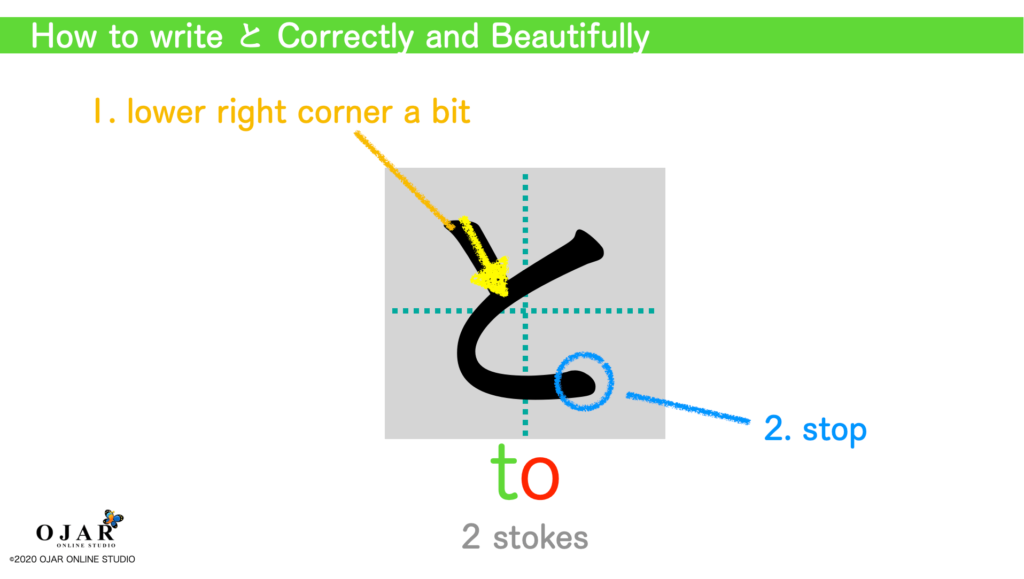
STROKE 1. Start from the upper right corner. Write to the lower right corner a bit. Stop at the end.
■ な行 | Hiragana na-gyou
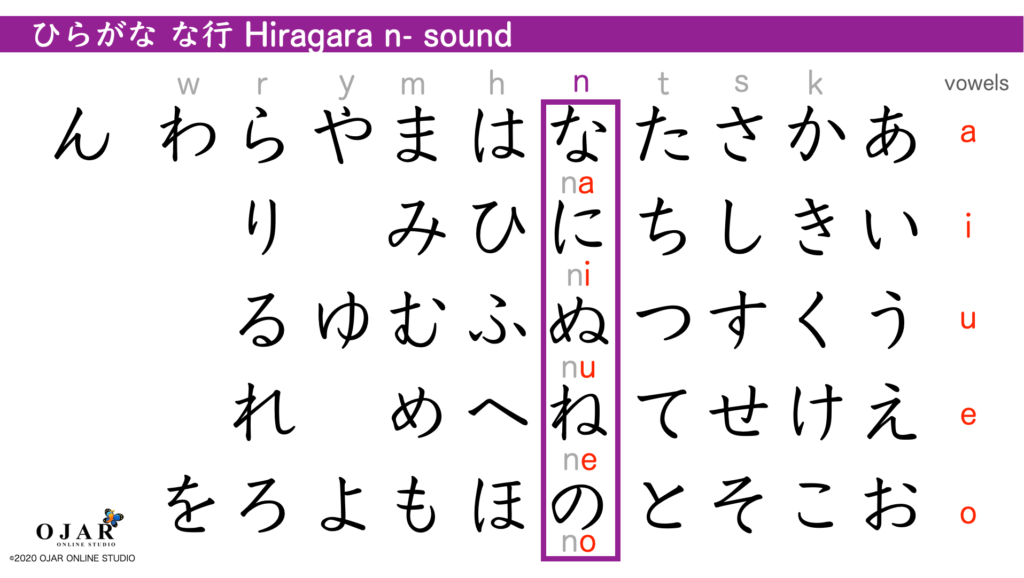
These characters create n sound of consonants and vowels. They are “な行 na-gyou”.
21. な How to Write na
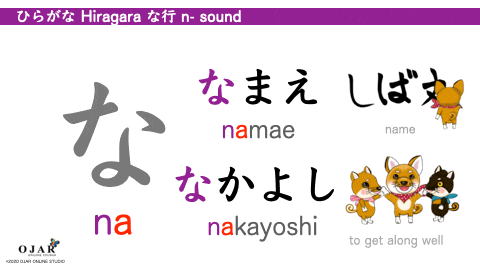
sound: na
stroke: 4
class: な行 na-gyou
The balance of な is difficult. You can learn with “た ta”.
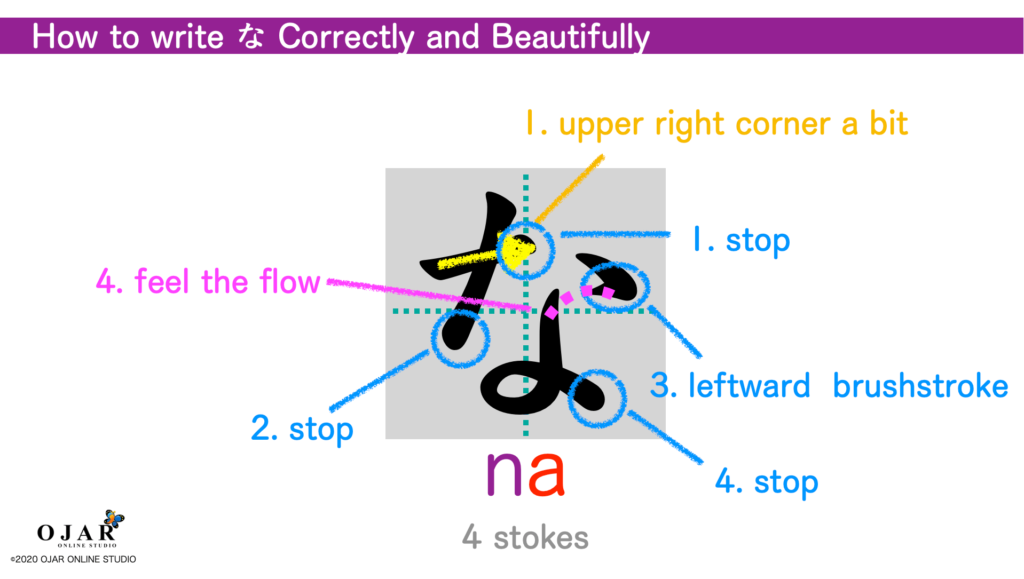
STROKE 1. Write to the upper right corner a bit. Stop at the end.
STROKE 2. Stop at the end.
STROKE 3. Write the leftward brushstroke at the end. And feel the flow to the 4th stroke.
STROKE 4. Stop at the end.
22. に How to Write ni
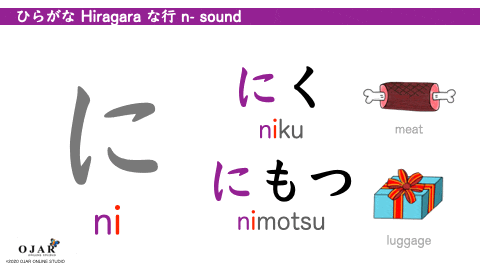
sound: ni
stroke: 3
class: な行 na-gyou
に is easy to write. you can learn with “こ ko”.
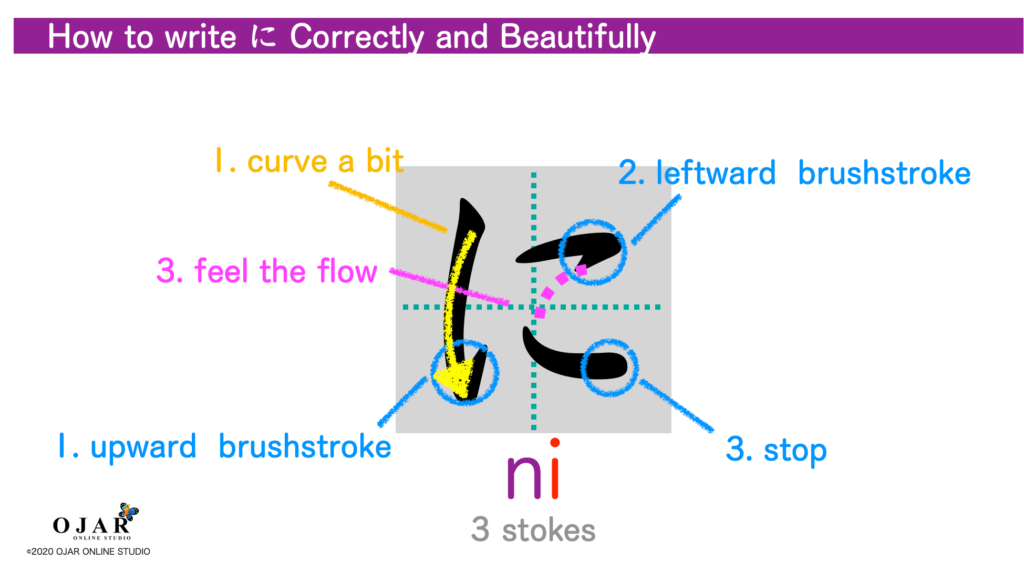
STROKE 1. Make it curve a bit. Write the upward brushstroke at the end.
STROKE 2. Write the leftward brushstroke at the end.
STROKE 3. Feel the flow to the 3rd stroke. Stop at the end.
23. ぬ How to Write nu
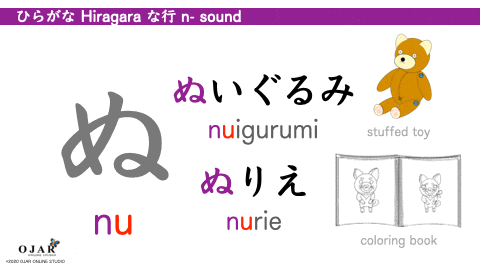
sound: nu
stroke: 2
class: な行 na-gyou
“ぬ nu” is difficult to write. You can learn with “あ a” and “め me”.
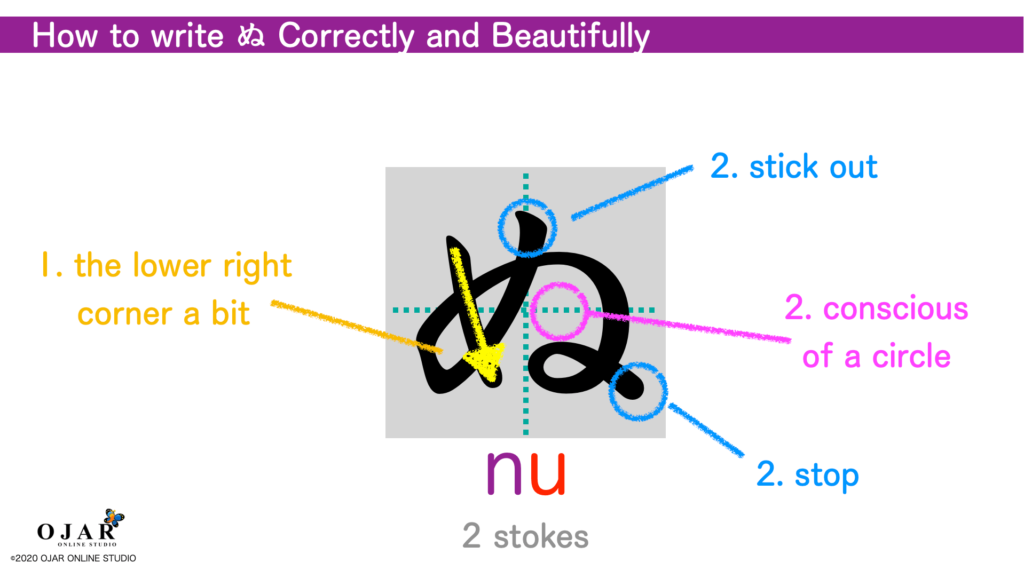
STROKE 1. Write to the lower right corner a bit.
STROKE 2. Don’t forget to stick out. Conscious of a circle inside. Stop at the end.
24. ね How to Write ne
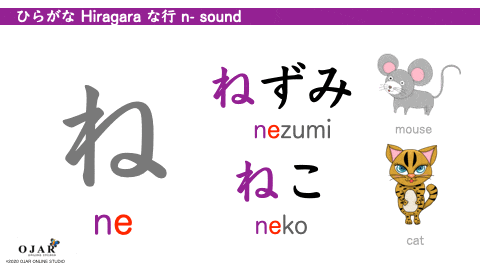
sound: ne
stroke: 2
class: な行 na-gyou
“ね
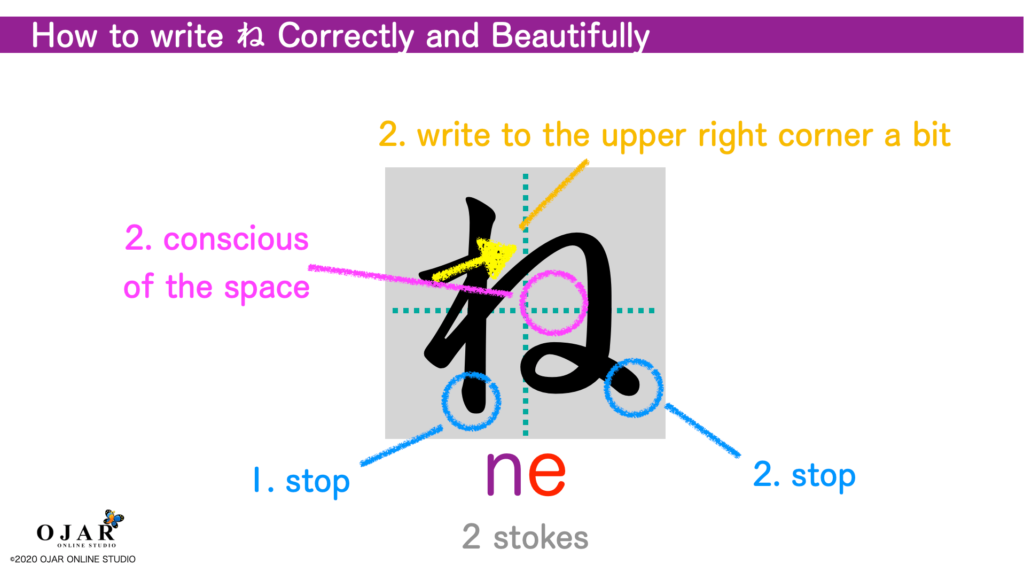
STROKE 1. Stop at the end.
STROKE 2. Write to the upper right corner a bit. Conscious of the space inside. Stop at the end.
25. の How to Write no
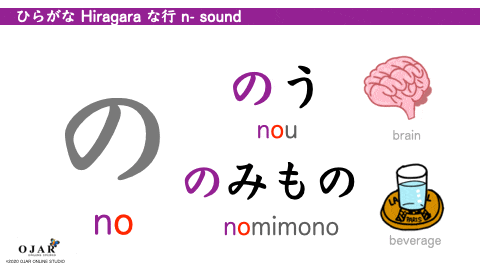
sound: no
stroke: 1
class: な行 na-gyou
“の no” is very simple. You can learn with “お o”, “あ a”, “め me” and “ぬ nu”.
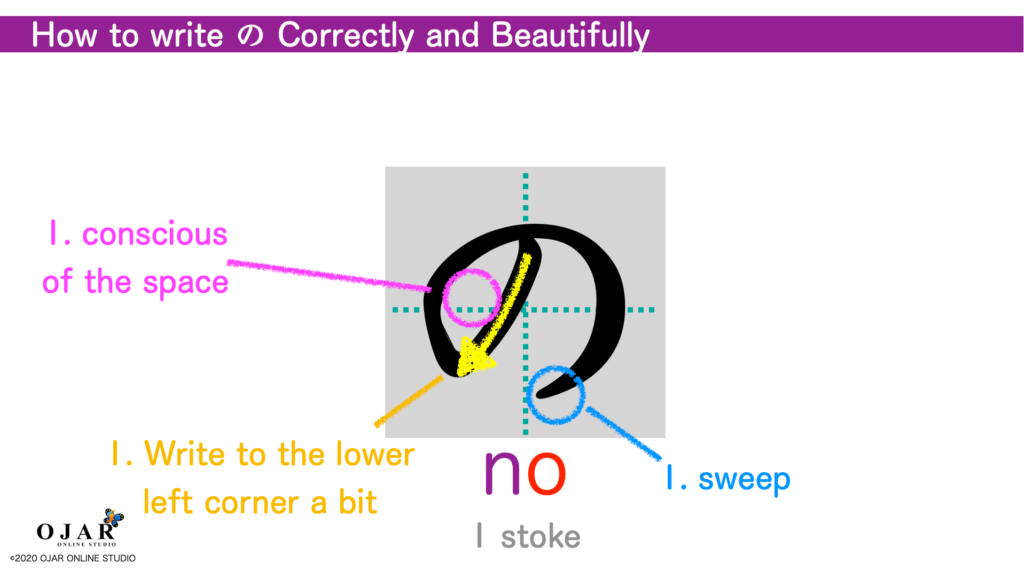
STROKE 1. Write to the lower-left corner a bit. Conscious of the space inside. Sweep at the end.
■ は行 | Hiragana ha-gyou
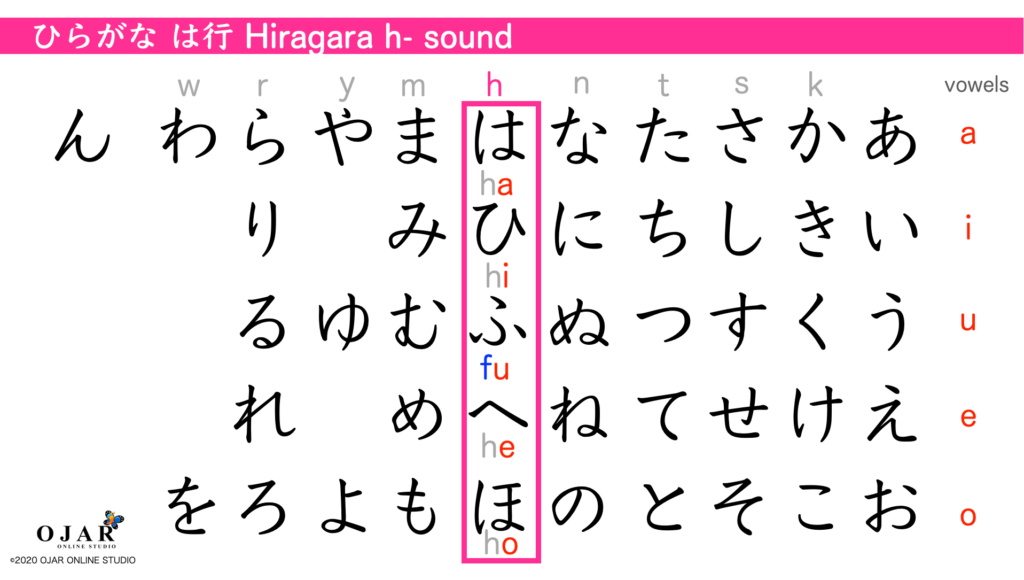
These characters create h sound of consonants and vowels. They are “は行 ha-gyou”.
21. は How to Write ha
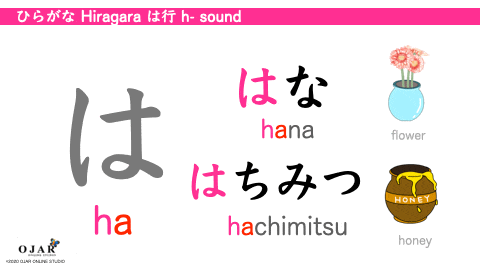
sound: ha
stroke: 3
class: は行 ha-gyou
The balance of は is difficult. You can learn with “け ke”, “ほ ho”, and “よ yo”.
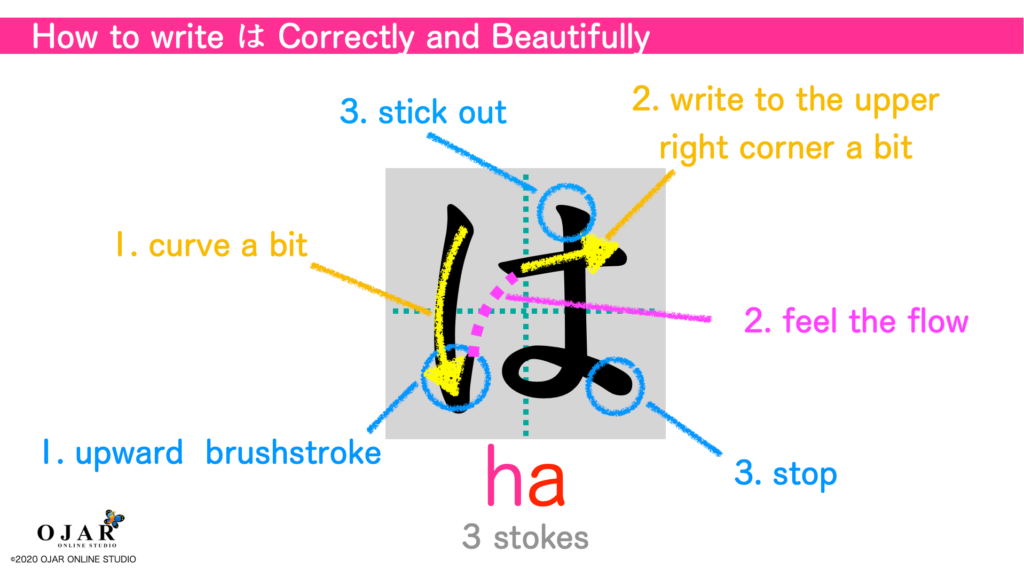
STROKE 1. Make it curve a bit. Write the upward brushstroke at the end.
STROKE 2. Feel the flow to the 2nd stroke. Write to the upper right corner a bit.
STROKE 3. Don’t forget to stick out. Stop at the end.
22. ひ How to Write hi
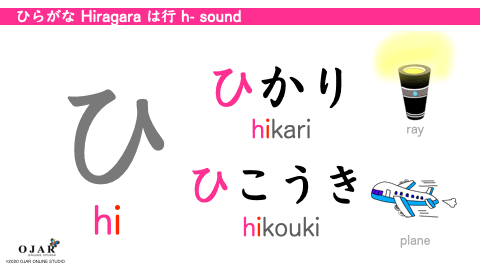
sound: hi
class: は行 ha-
“ひ hi” is easy to write. you can learn with “て te”.
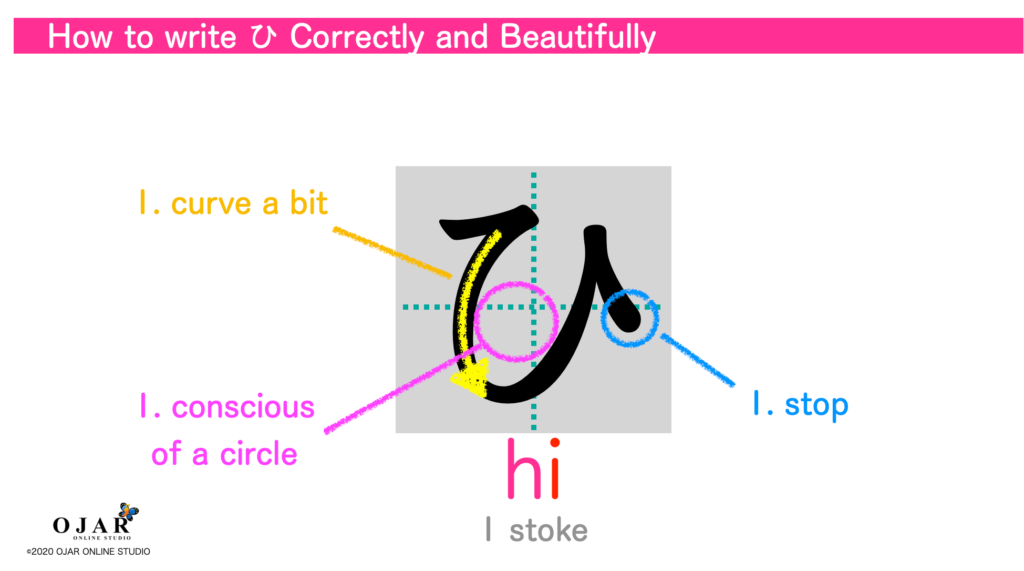
STROKE 1. Make it curve a bit. Conscious of a circle inside. Stop at the end.
23. ふ How to Write fu
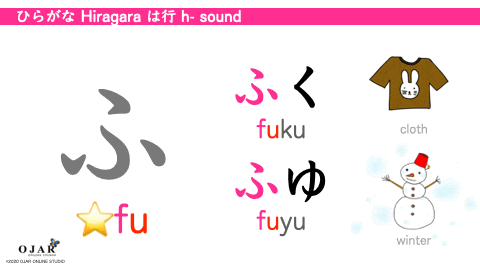
sound: fu
stroke: 4
class: は行 ha-gyou
The balance of “ふ fu” is difficult. You can learn with “い i” and “う u”. But be careful with the phonetic notation. It’s NOT “hu”. However, you can use “hu” when you type on your keyboard.
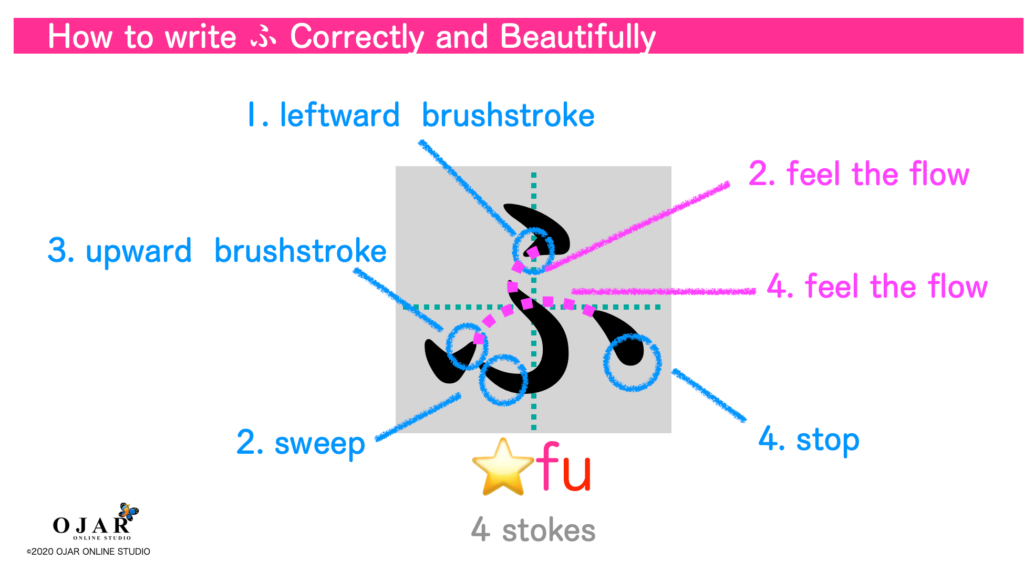
STROKE 1. Write the leftward brushstroke at the end.
STROKE 2. Feel the flow to the 2nd stroke. Sweep at the end.
STROKE 3. Write the upward brushstroke at the end.
STROKE 4. Feel the flow to the 4th stroke. Stop at the end.
24. へ How to Write he
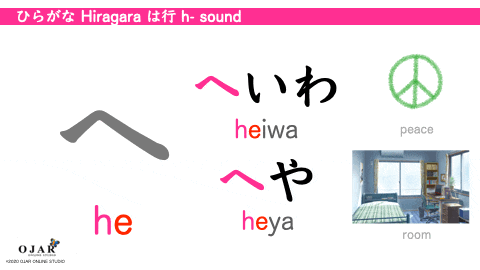
sound: he
stroke: 1
class: は行 ha-
“へ he” is very easy. You can learn with “く ku”.
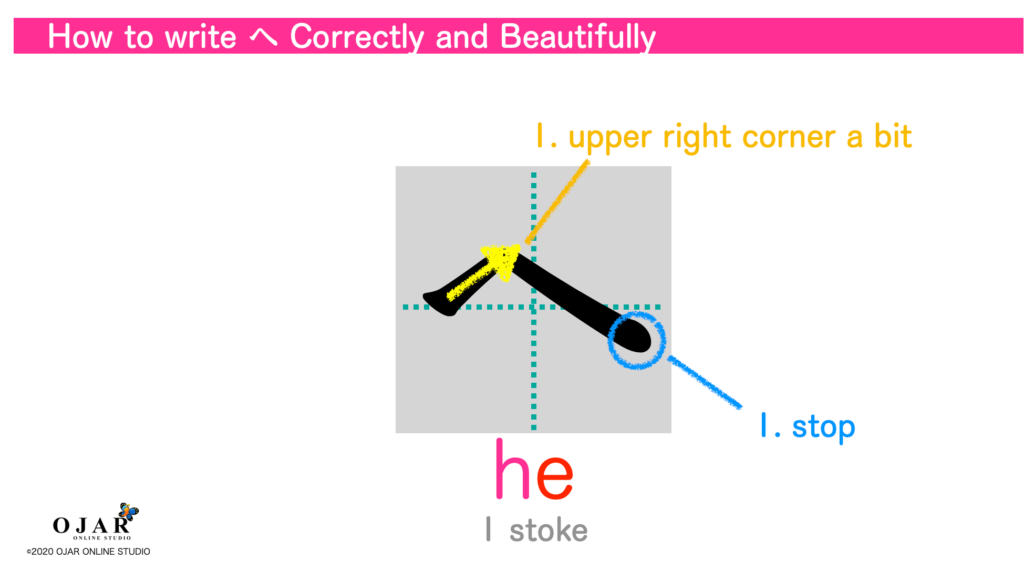
STROKE 1. Write to the upper right corner a bit. Stop at the end.
25. ほ How to Write ho
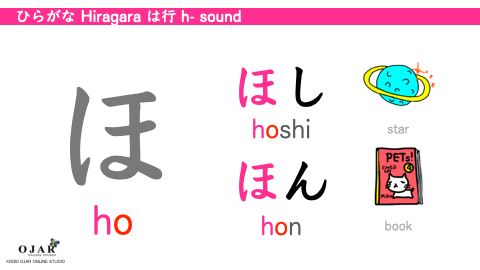
sound: ho
stroke: 4
class: は行 ha-
The balance of “ほ ho” is difficult. You can learn with “は ha” and “ま ma”.
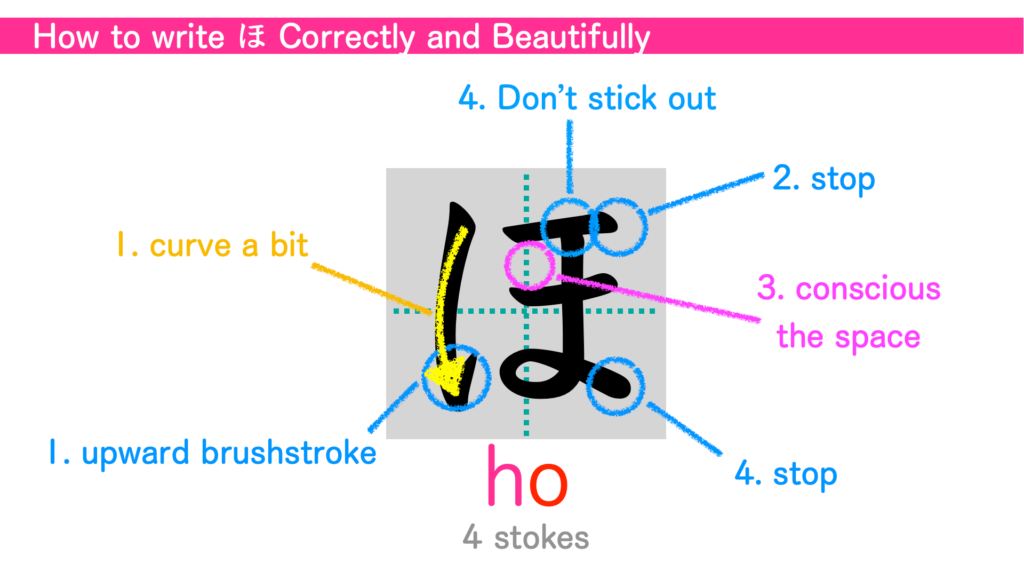
STROKE 1. Make it curve a bit. Write the upward brushstroke at the end.
STROKE 2.
STROKE 3. Conscious of a circle inside.
STROKE 4.DO NOT stick out. Stop at the end.
■ ま行 | Hiragana ma-gyou
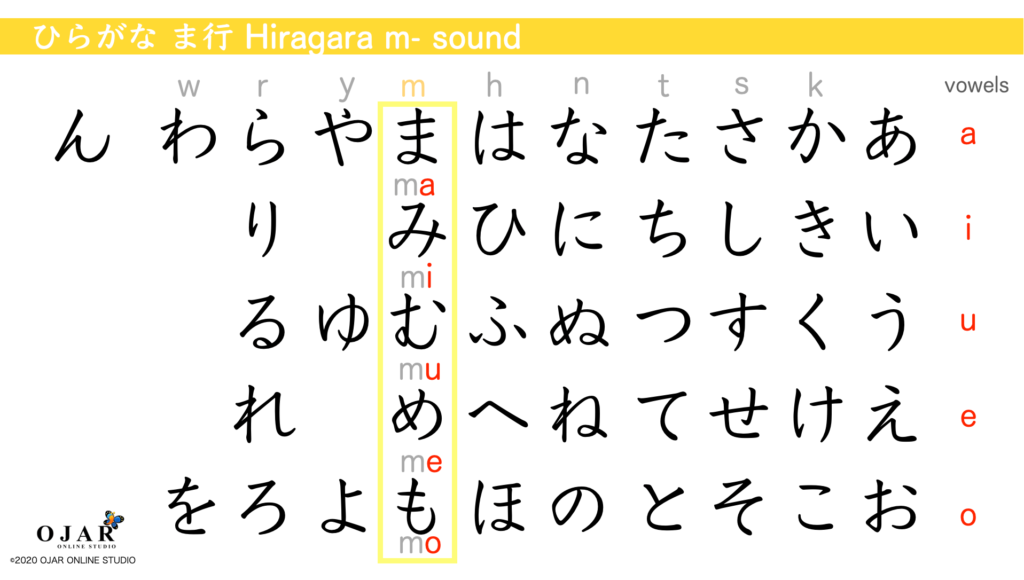
These characters create m sound of consonants and vowels. They are “ま行 ma-gyou”.
31. ま How to Write ma
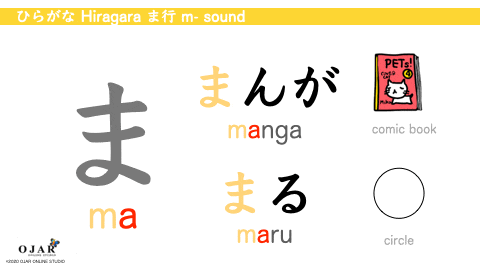
sound: ma
stroke: 3
class: ま行 ma-gyou
“ま ma” is easy to write. You can learn with “ほ ho” and “も mo”.
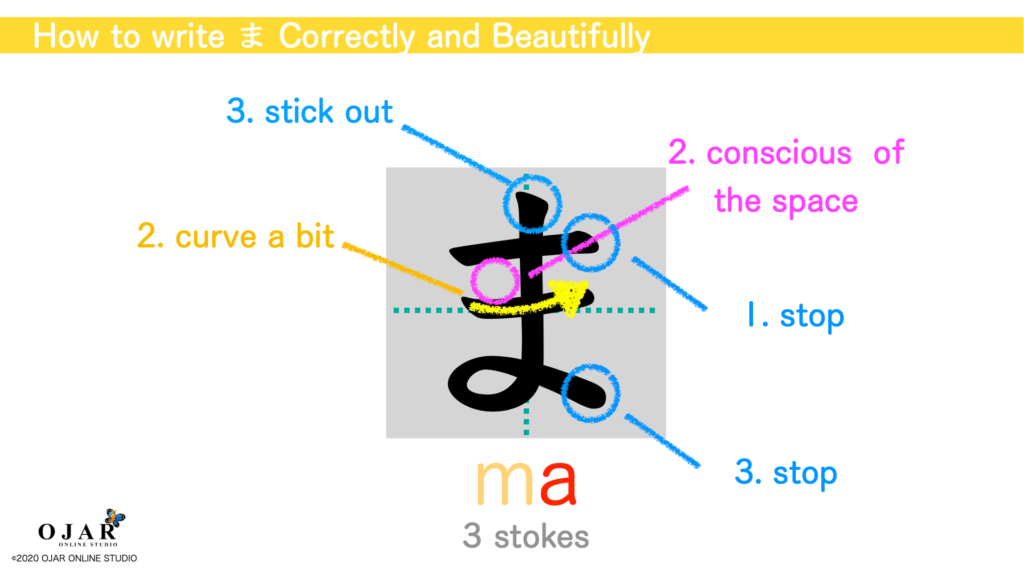
STROKE 1. Stop at the end.
STROKE 2. Conscious of the space. Make it curve upward a bit.
STROKE 3. Don’t forget to stick out. Stop at the end.
32. み How to Write mi
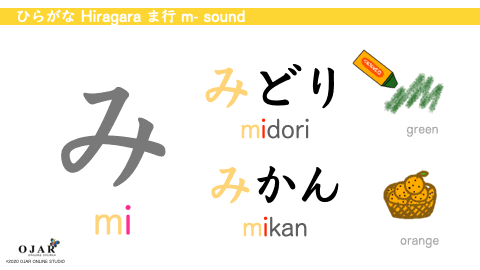
sound: ma
str
class: ま行 ma-
“ま ma” is easy to write. You can learn with “ほ ho” and “も mo”.
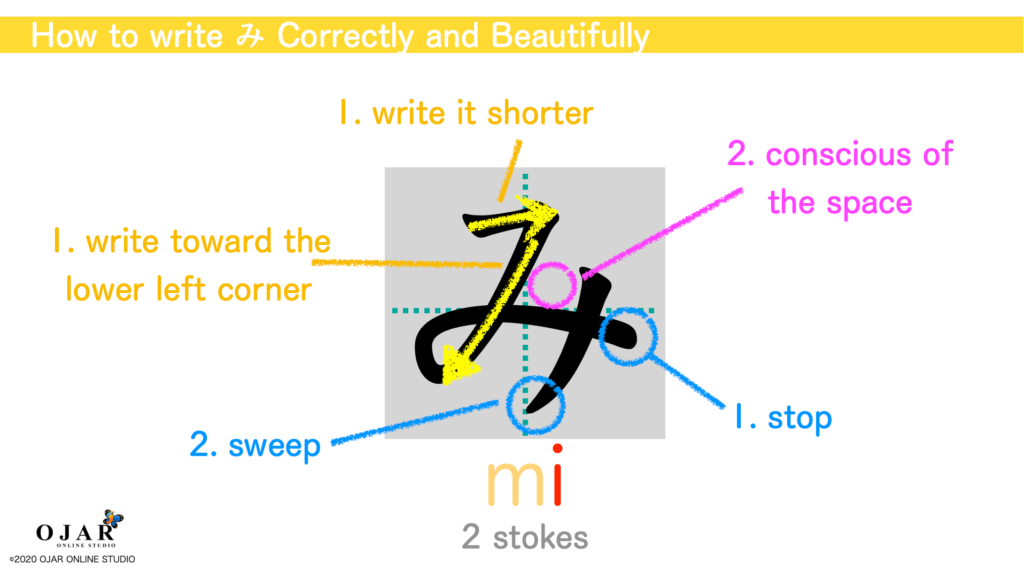
STROKE 1. Stop at the end.
STROKE 2. Conscious of the space. Make it curve upward a bit.
STROKE 3. Don’t forget to stick out. Stop at the end.
33. む How to Write mu
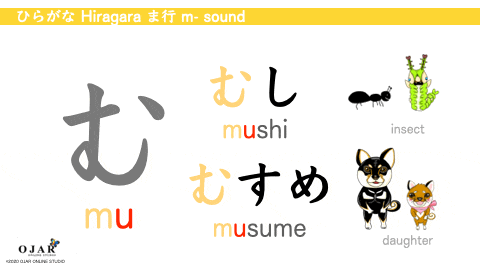
sound: mu
stroke: 3
class: ま行 ma-
The balance of “む mu” is difficult. You can learn with “す su” and “お o”.
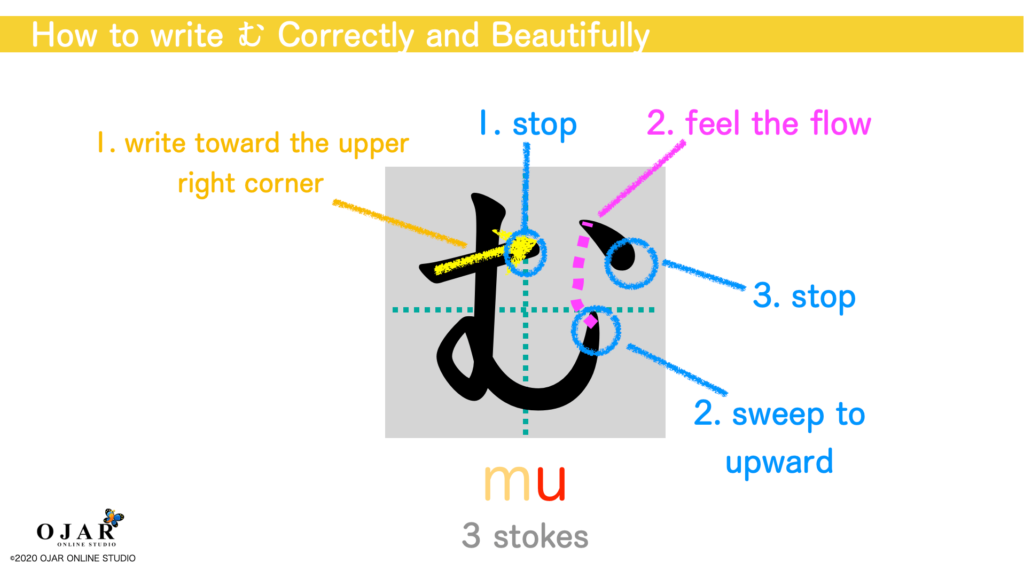
STROKE 1. Write toward the upper right corner. Stop at the end.
STROKE 2. Sweep to upward. Feel the flow to the 3rd stroke. STROKE 3. Stop at the end.
34. め How to Write me
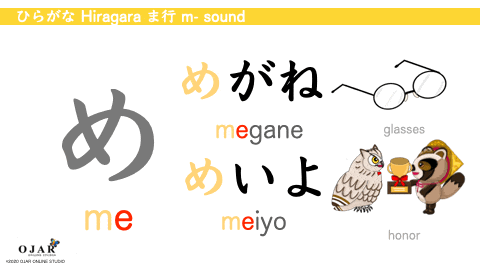
sound: me
stroke: 2
class: ま行 ma-gyou
The balance of “め me” is difficult. You can learn with “あ a”, “お o”, “ぬ nu” and “の no”.
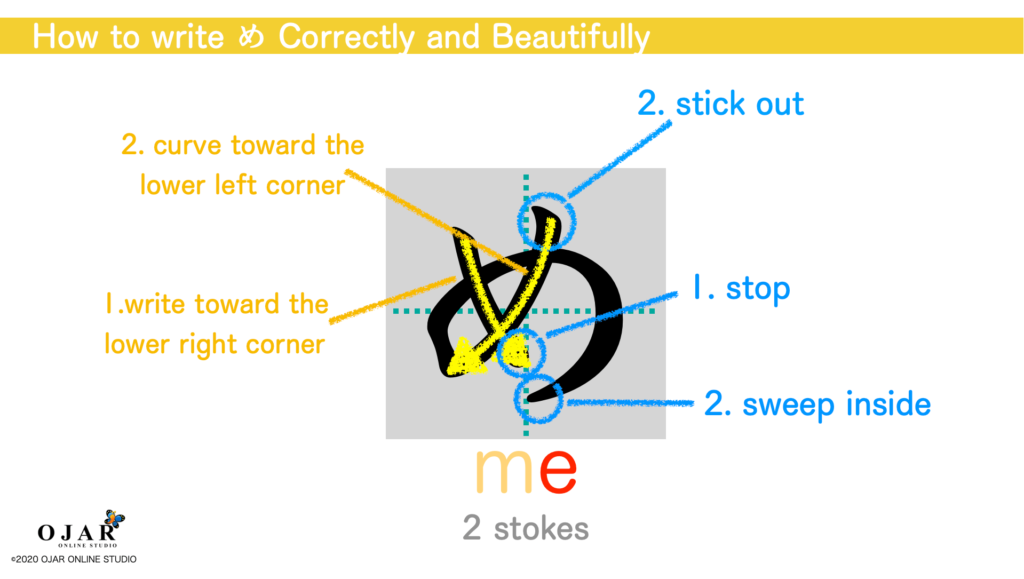
STROKE 1. Curve toward the lower right corner. Stop at the end.
STROKE 2. Don’t forget to stick out. Write toward the lower-left corner. Sweep inside.
35. も How to Write mo
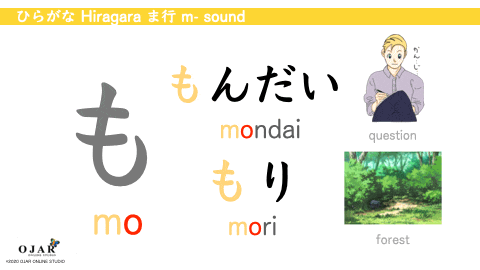
sound: mo
str
class: ま行 ma-gyou
The balance of “め me” is difficult. You can learn with “あ a”, “お o”, “ぬ nu” and “の no”.
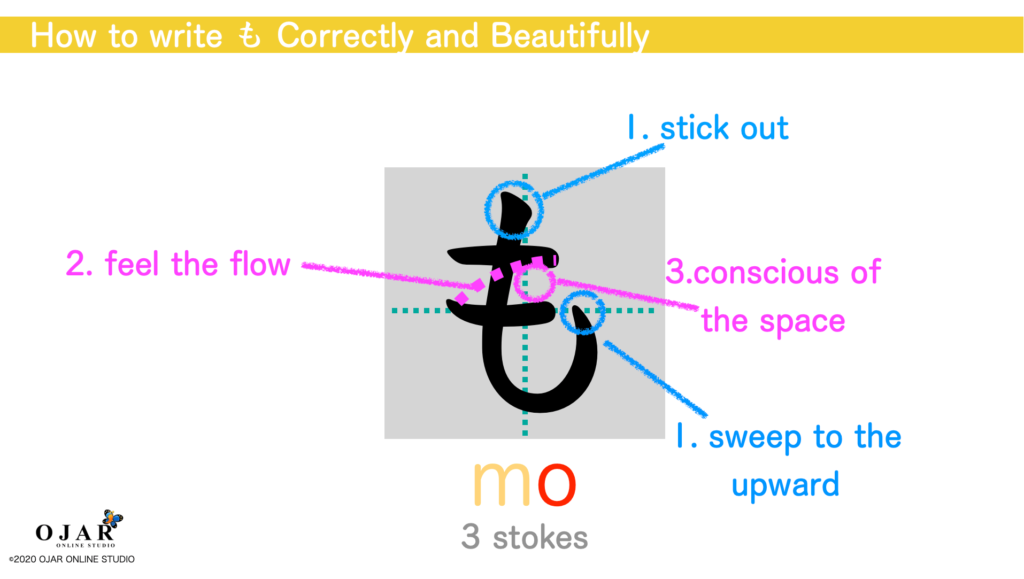
STROKE 1. Make it stick out. Sweep to the upward at the end.
STROKE 2. Feel the flow to the 2nd stroke.
STROKE 3. Conscious of the space between the 1st and 2nd stroke.
■ や行 | Hiragana ya-gyou
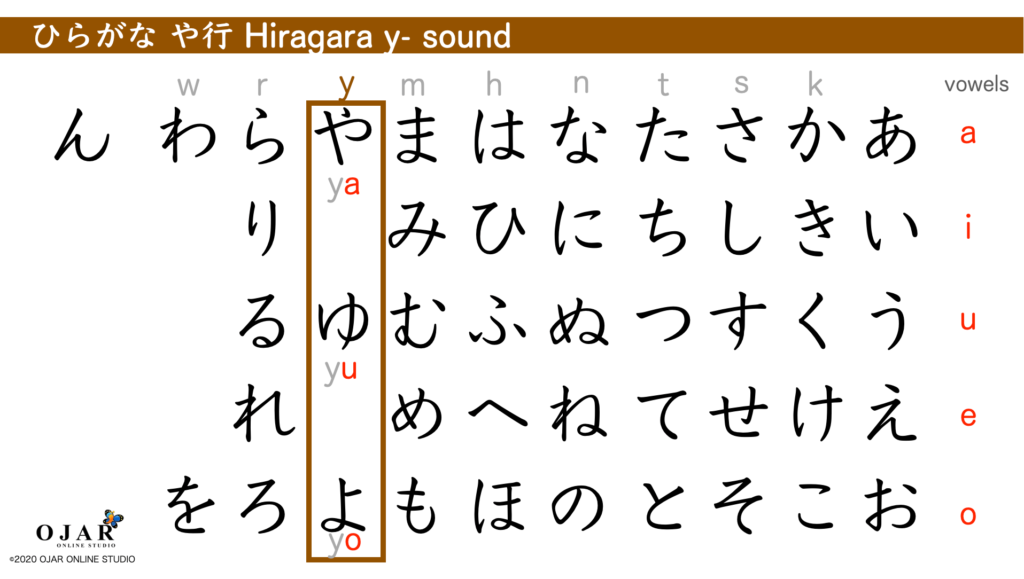
These characters create y sound of consonants and vowels. They are “や行 ya-gyou”.
Originally, this column had 5 sounds “や ya い
36. や How to Write ya
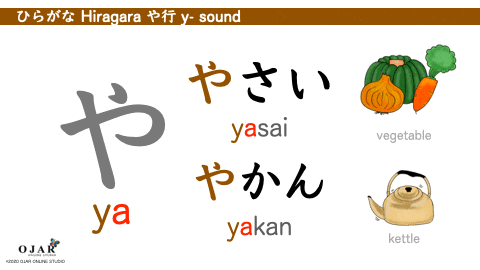
sound: ya
stroke: 3
class: や行 ya-gyou
The balance of や is difficult. You can learn with “か ka” and “ゆ yu”.
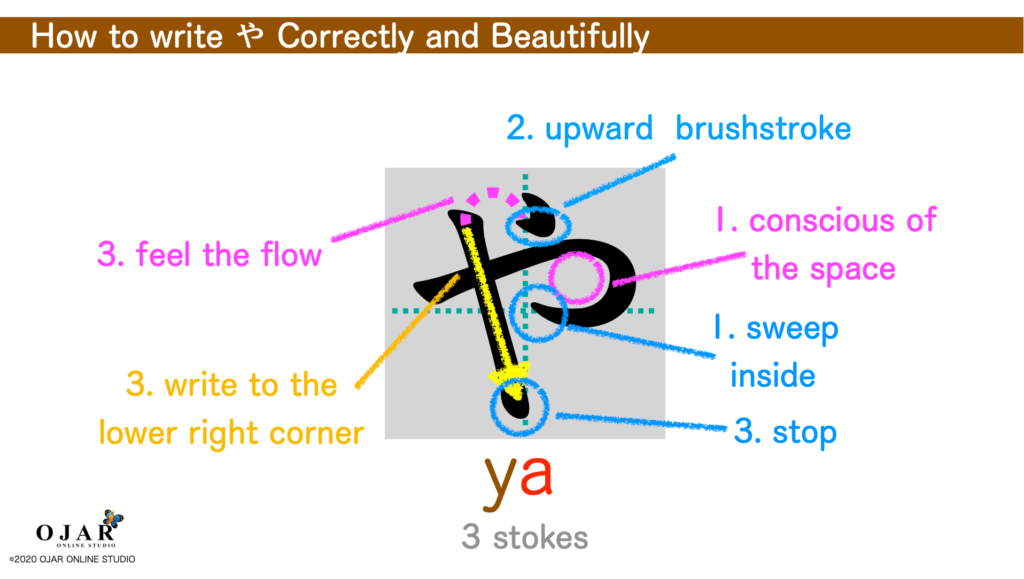
STROKE 1.Conscious of the space in the middle. Sweep inside.
STROKE 2. Don’t forget the upward brushstroke.
STROKE 3. Feel the flow to the 3rd stroke. Write to the lower right corner.
37. ゆ How to Write yu
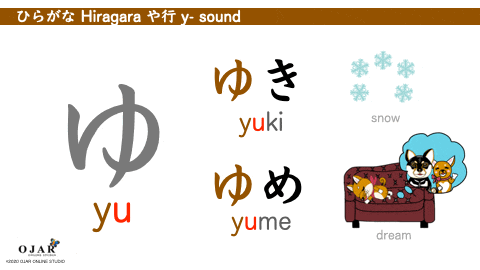
sound: yu
stroke: 2
class: や行 ya-gyou
The balance of “ゆ yu” is difficult. You can learn with “や ya” and “み mi”.
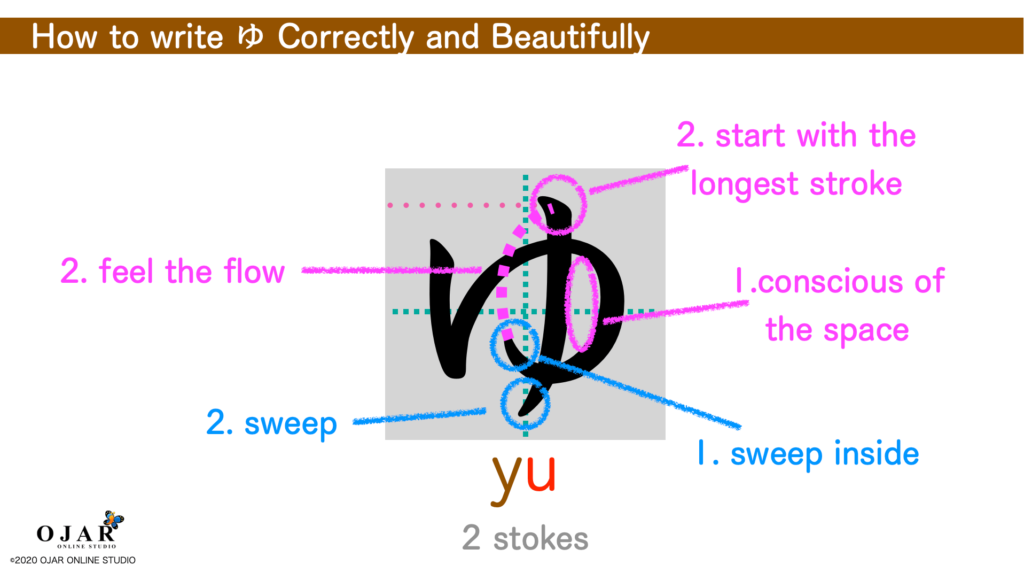
STROKE 1. Conscious of the space in the middle. Sweep inside.
STROKE 2. Don’t forget the upward brushstroke.
STROKE 3. Feel the flow to the 3rd stroke. Write to the lower right corner.
38. よ How to Write yo
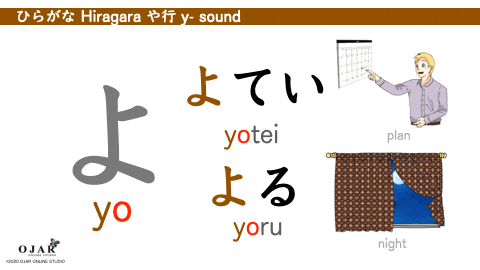
sound: yo
stroke: 2
class: や行 ya-gyou
The balance of “よ yo” is easy. You can learn with “は ha”.
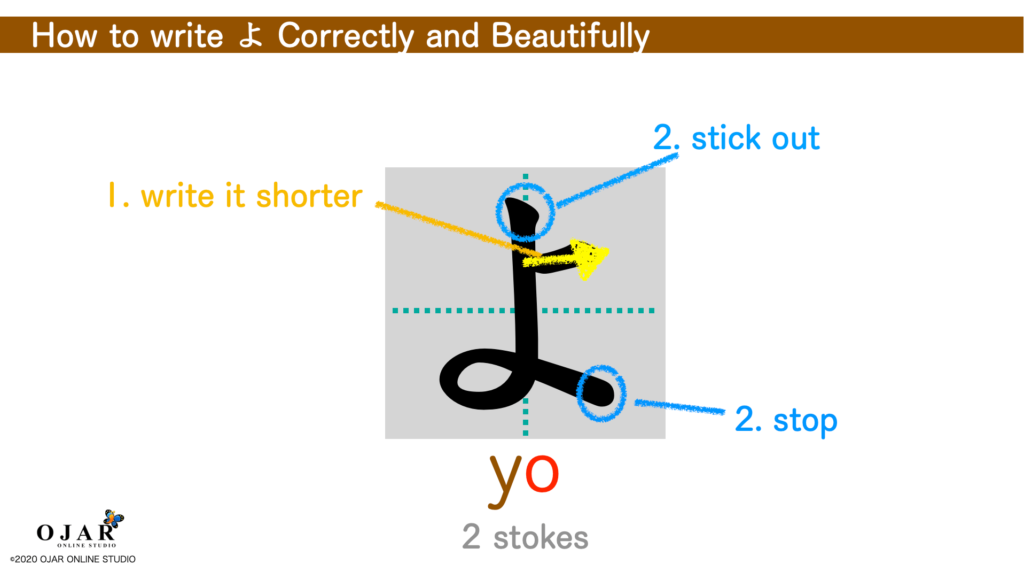
STROKE 1. Write a line shorter.
STROKE 2. Make it stick out. Stop at the end.
■ ら行 | Hiragana ra-gyou
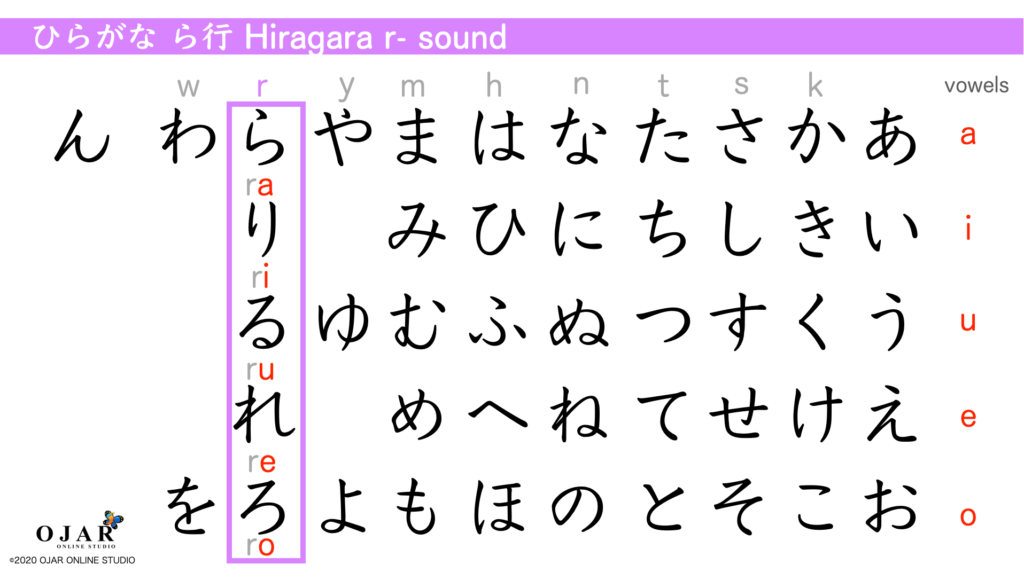
These characters create r sound of consonants and vowels. They are “ら行 ra-gyou”.
39. ら How to Write ra
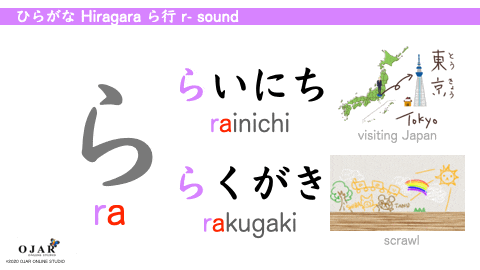
sound: ra
stroke: 2
class: ら行 ra-gyou
The balance of “ら ra” is easy. You can learn with “う u”, “ろ ro”, and “る ru”.
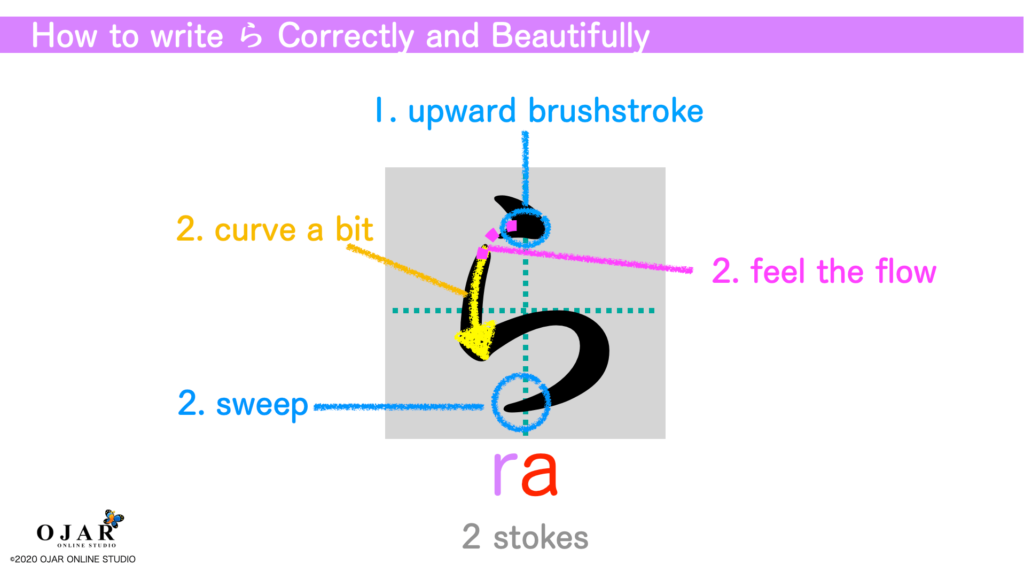
STROKE 1. Write upward brushstroke.
STROKE 2. Feel the flow to the 2nd stroke. Make it curve in the middle a bit. Sweep it at the end.
40. り How to Write ri
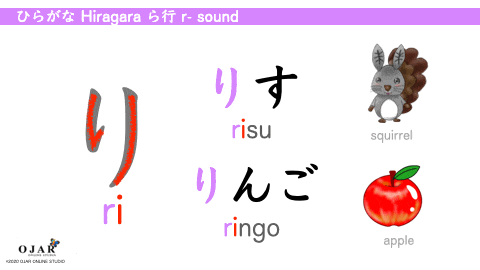
sound: ri
stroke: 2
class: は行 ha-gyou
“り ri” is easy to write. you can learn with “い i”.
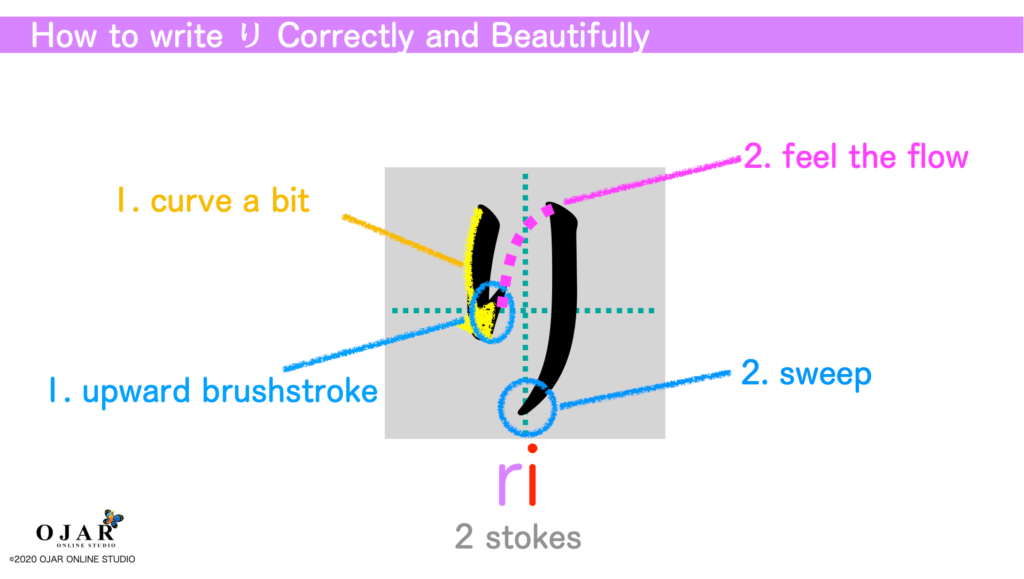
STROKE 1. Curve in the middle a bit. Don’t forget the upward brushstroke.
STROKE 2. Feel the flow to the 2nd stroke. Sweep at the end.
41. る How to Write ru
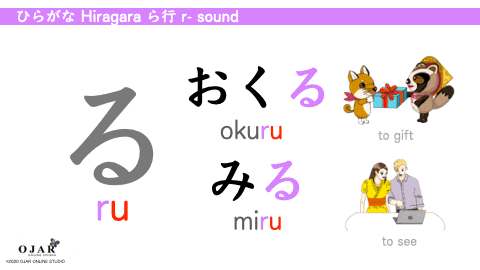
sound: ru
stroke: 1
class: ら行 ra-gyou
The balance of “る ru” is easy. You can learn with “う u”, “ら ra” and ろ ro”.
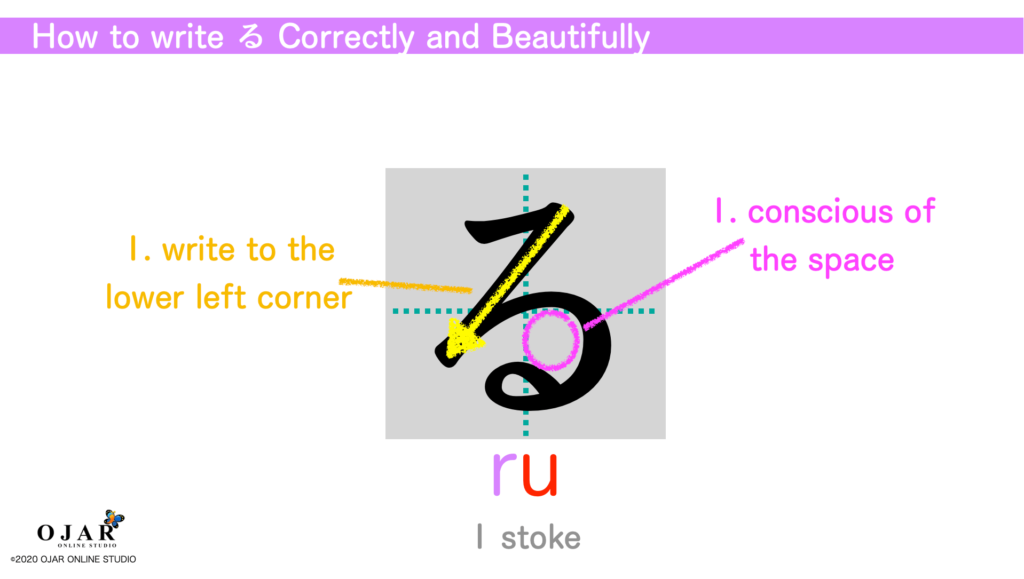
STROKE 1. Write to the lower-left corner. Conscious o
42. れ How to Write re
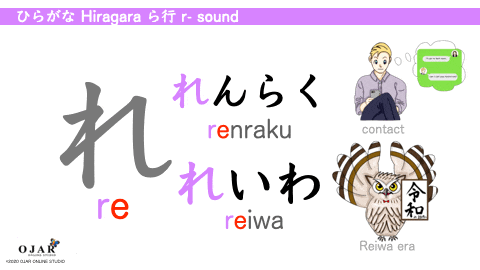
sound: re
stroke: 1
class: ら行 ra-gyou
“れ re” is not difficult. You can learn with “わ wa”, “ね ne” and “え e”.
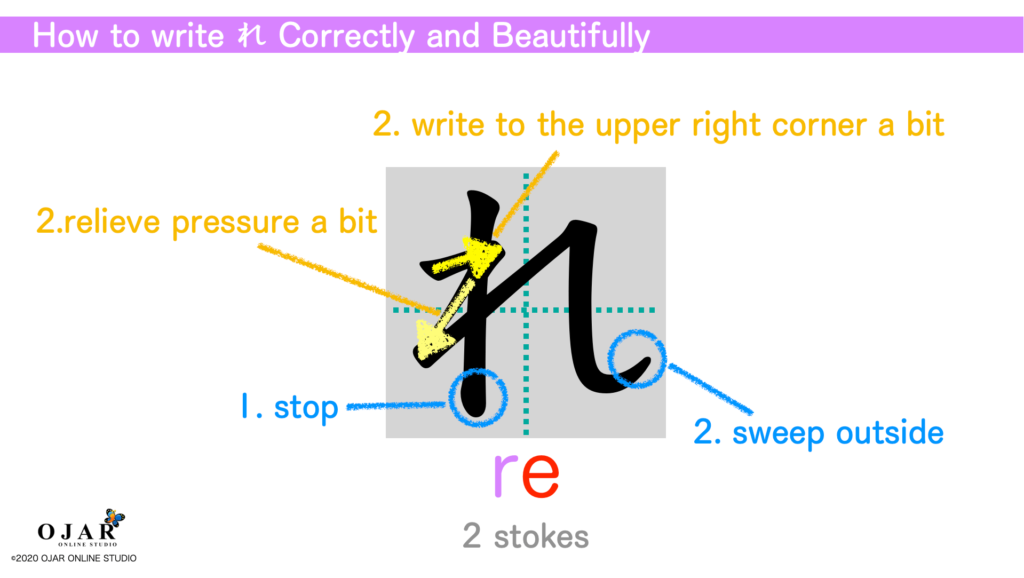
STROKE 1. Stop at the end.
STROKE 2. Write to the upper right corner a bit. Relieve pressure a bit. Sweep outside.
43. ろ How to Write ro
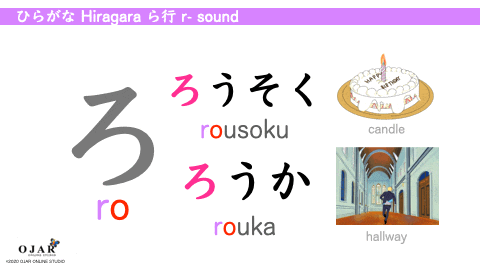
sound: ro
class: ら行
The balance of “る ru” is easy. You can learn with “う u”, “ら ra” and ろ ro”.
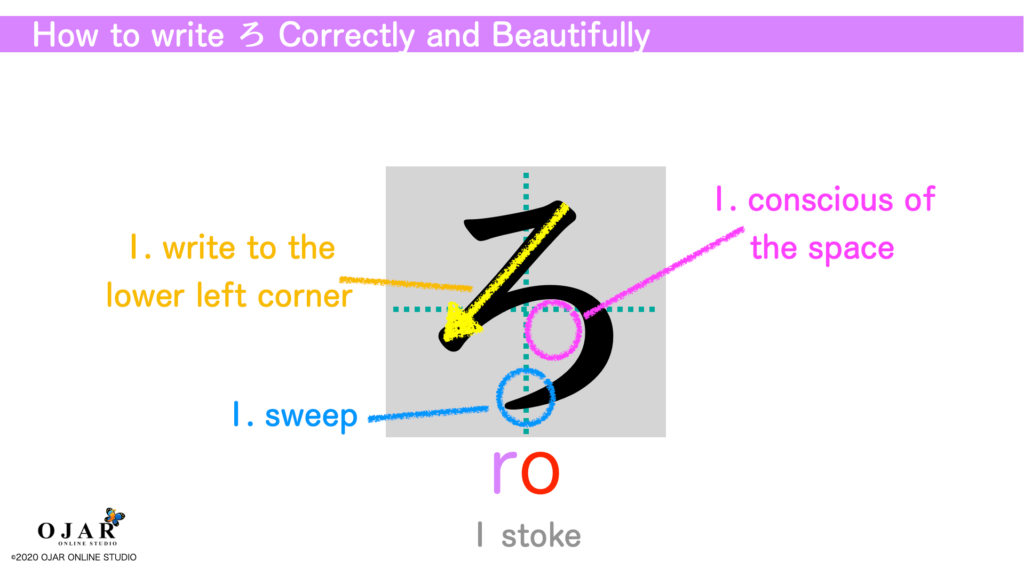
STROKE 1. Write to the lower-left corner. Conscious of the space in the middle.
■ わ行 | Hiragana wa-gyou
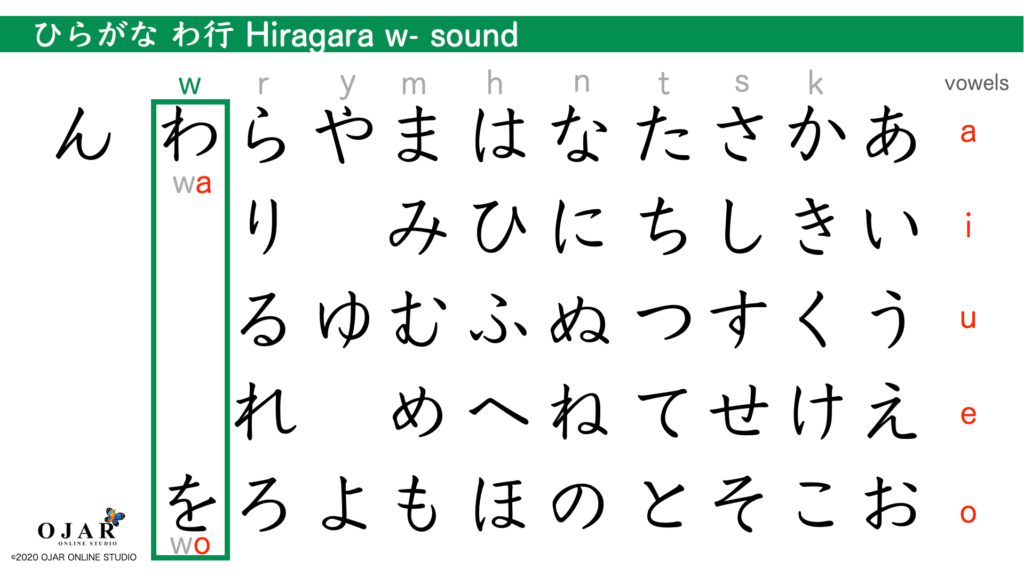
The balance of わ is not difficult. You can learn with “れ re”, “ね ne”, and “え e”.
44. わ How to Write wa
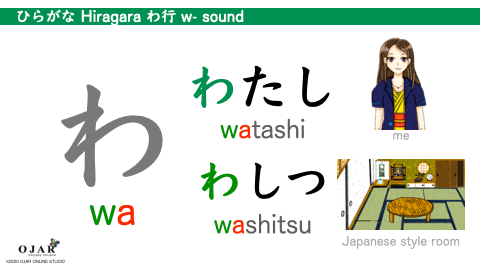
sound: wa
stroke: 2
class: わ行 wa-gyou
The balance of わ is not difficult. You can learn with “れ re”, “ね ne”, and “え e”.
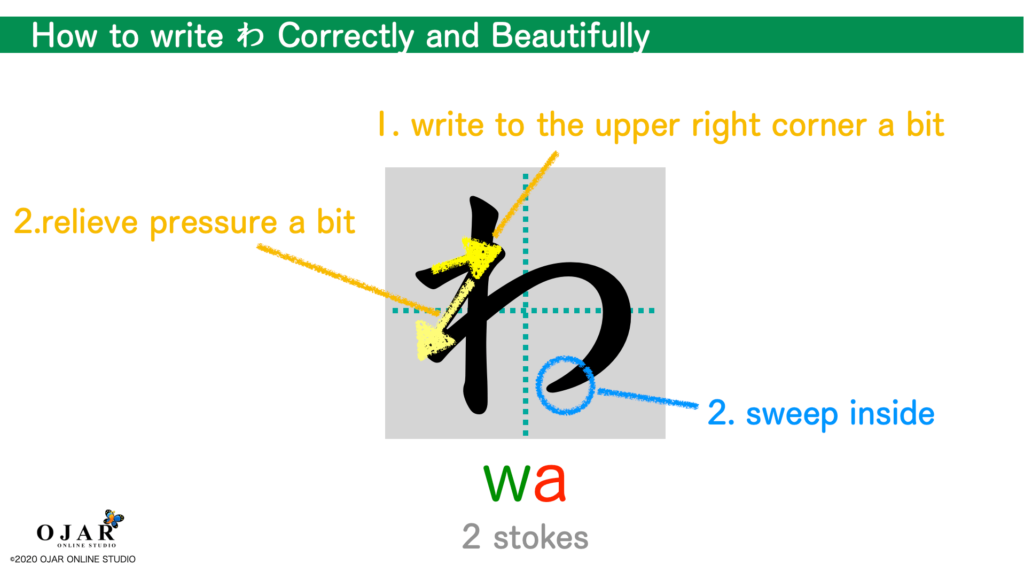
STROKE 1. Write to the upper right corner a bit.
STROKE 2. Relieve pressure a bit. Sweep inside at the end.
45. を How to Write wo
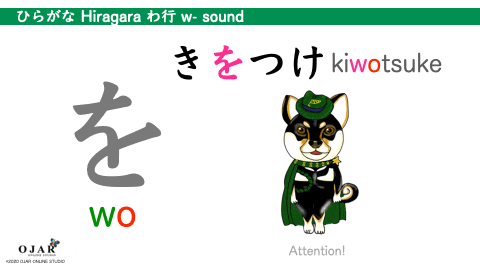
sound: wo
stroke: 3
class: わ行 wa-gyou
The balance of わ is not difficult. You can learn with “れ re”, “ね ne”, and “え e”.
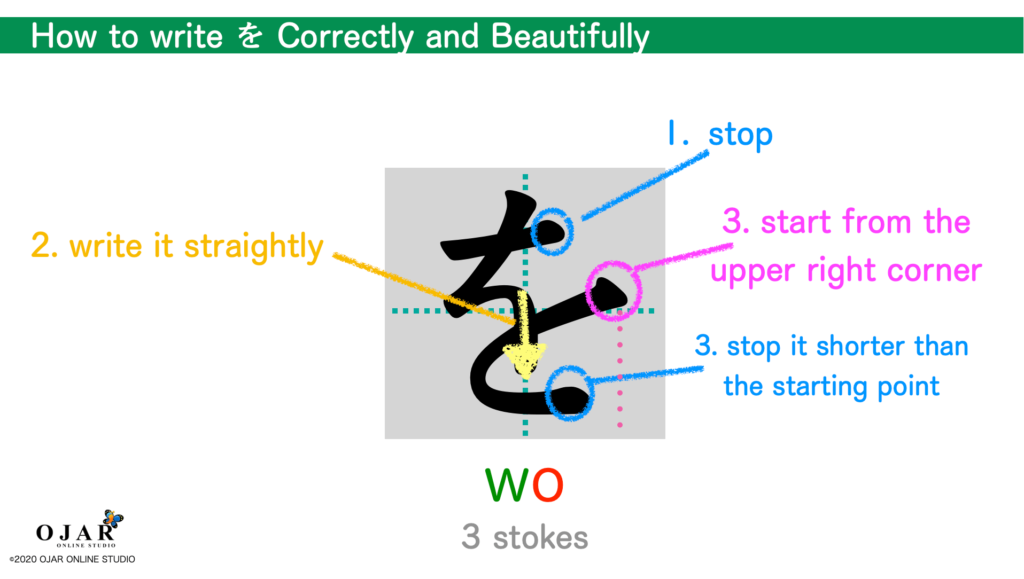
STROKE 1. Write to the upper right corner a bit.
STROKE 2. Relieve pressure a bit. Sweep inside at the end.
■ ん | Hiragana silent sound
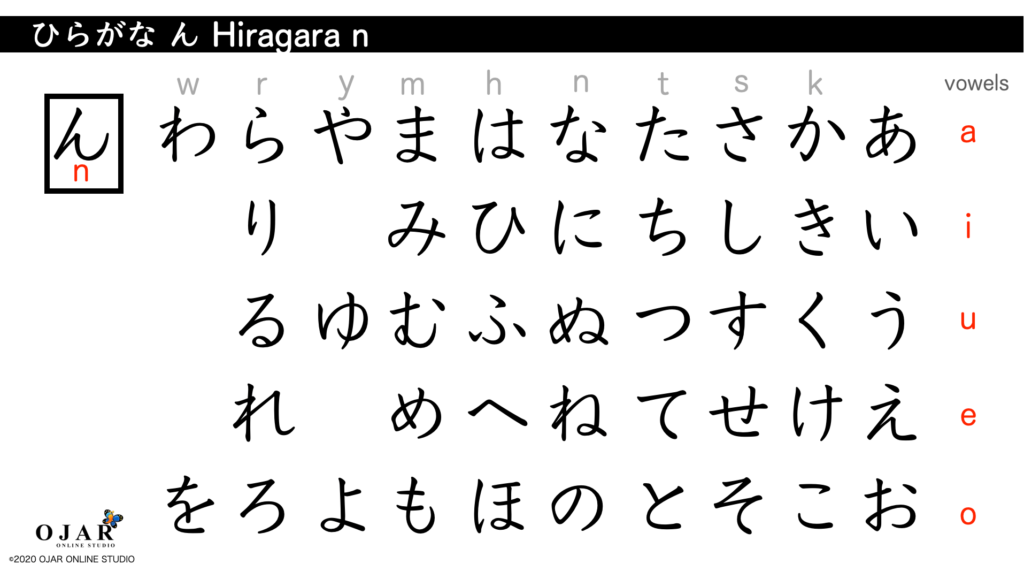
This character sounds n. It is the same sound of these words of n; “pen” or “London”. You should type “
46. ん How to Write n
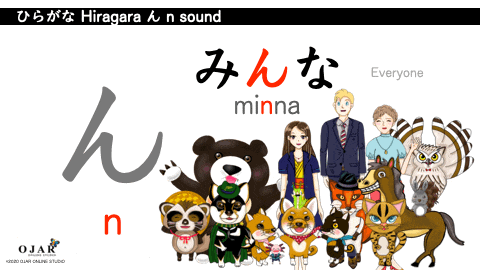
sound: n
stroke: 1
class: none
The balance of “ん n” is difficult. You can learn with “え e”.
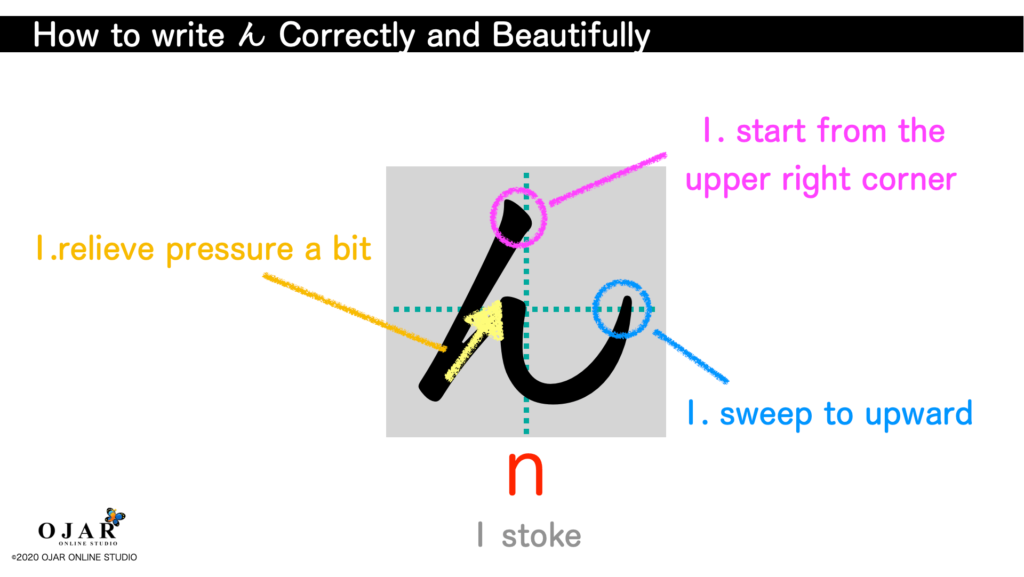
STROKE 1. Start from the upper right corner. Relieve pressure a bit. Sweep to upward.
Hiragana chart included Stroke Order
Here is the Hiragana chart included stroke oder.
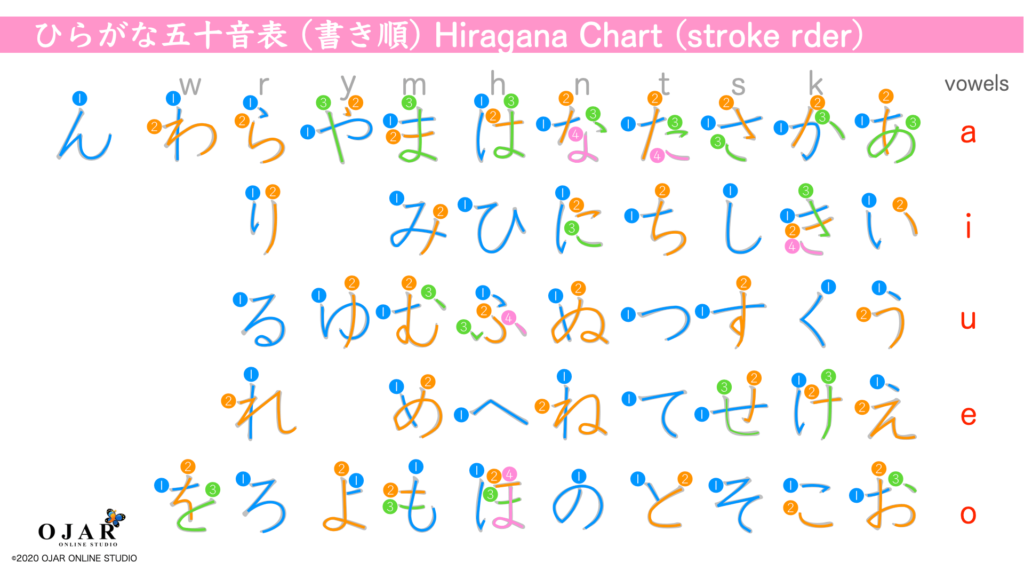
ひらがな の 段 Column of Hiragana
You can learn this section as an additional lesson.
“段 dan” is column in English.
It is very helpful for you to learn each column of Hiragana when you learn Verb conjugations etc.
We certainly learn this when we are a child as one of learning Hiragana. Actually, there are some Japanese people who didn’t memorize 段 like my students. They were very struggled to learn Japanese grammar in Japanese class when they became age 14.
When we learn these columns, we include the omitted sounds, “やいゆえよ” and “わゐうゑお”, in the modern Hiragana chart.
47. あ段 | a – dan
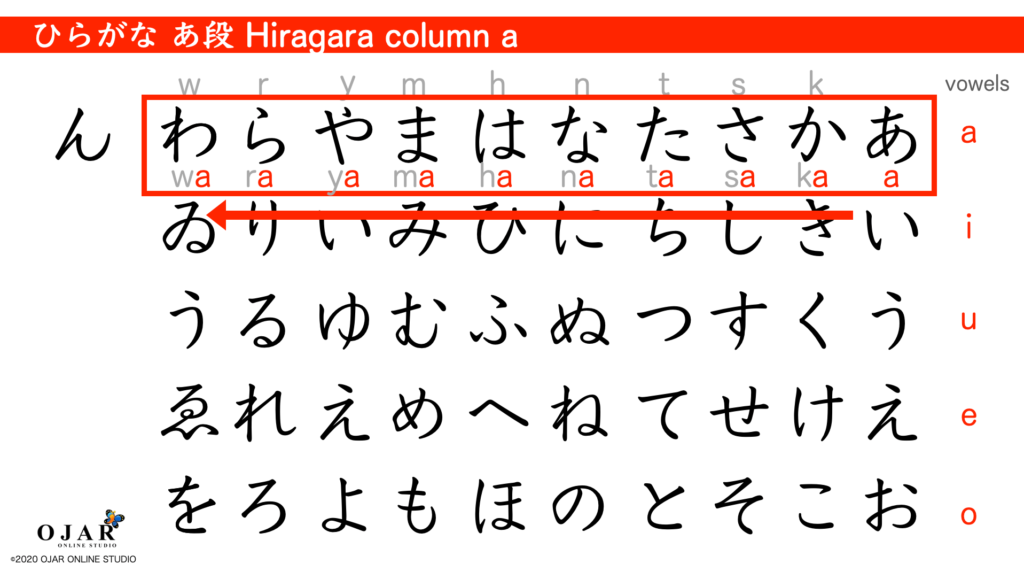
“あ段 a-dan” are composed of “a sound” and consonants.
あ か さ た な は ま や ら わ
a ka sa ta na ha ma ya ra wa
48. い段 | i – dan
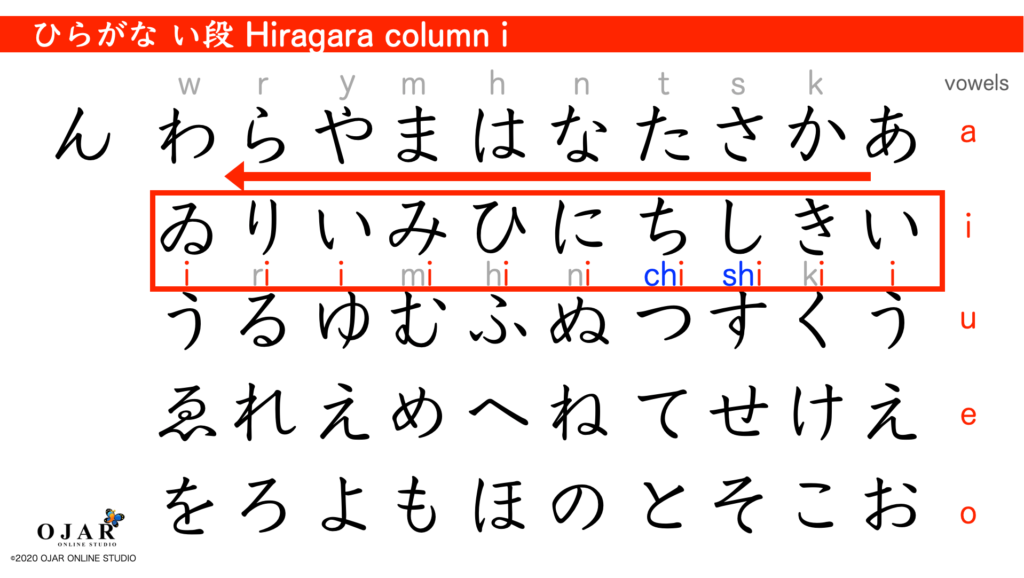
“い段 i-dan” are composed of “i sound” and consonants.
い き し ち に ひ み い り ゐ
i ki shi chi ni hi mi i ri i
49. う段 | u – dan
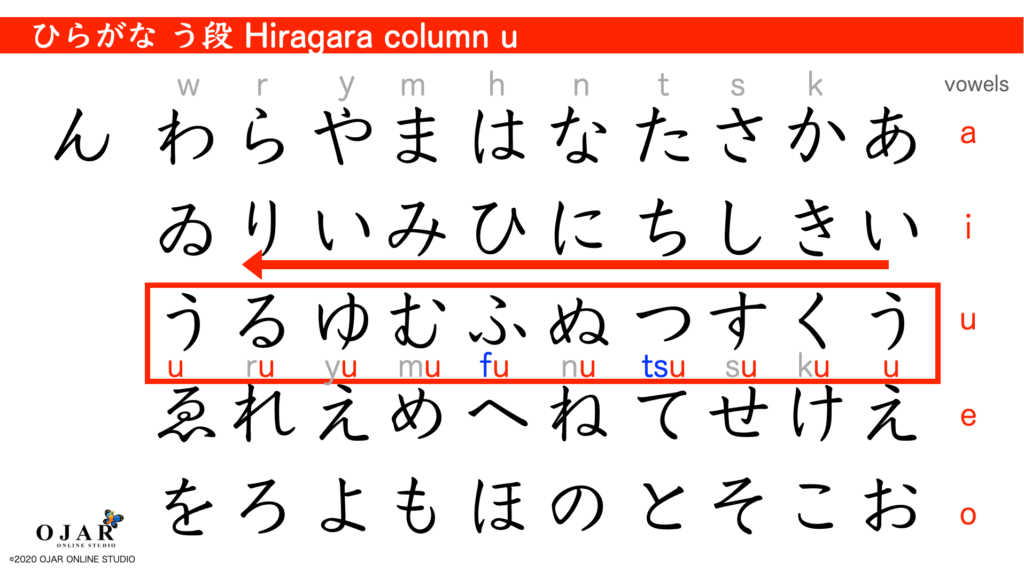
“う段 u-dan” are composed of “u sound” and consonants.
うくす つ ぬ ふ む ゆ る う
u ku su tsu nu fu mu yu ru u
50. え段 | e – dan
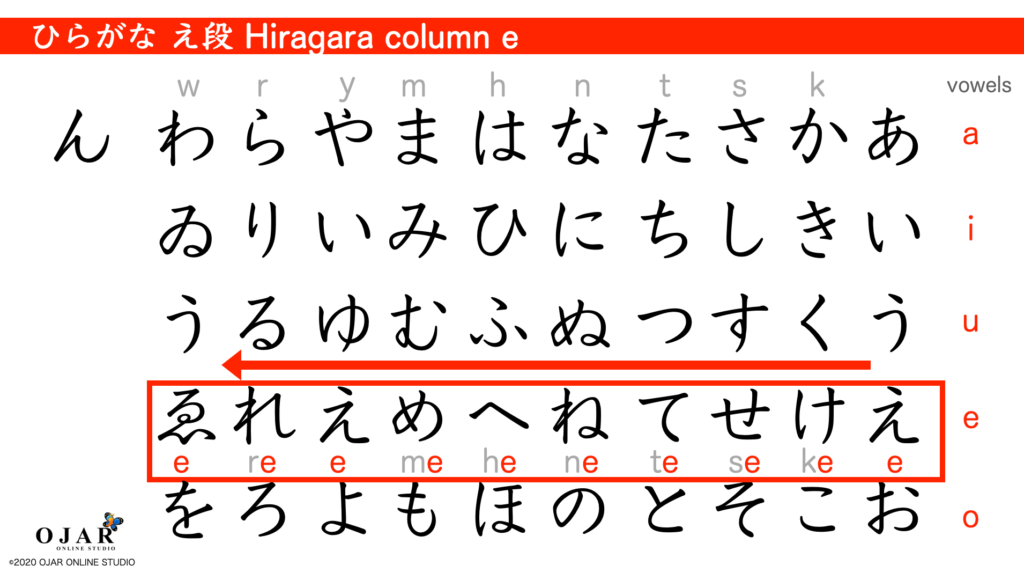
“え段 e-dan” are composed of “e sound” and consonants.
え け せ て ね へ め え れ ゑ
e ke se te ne he me e re e
51. お段 | o – dan
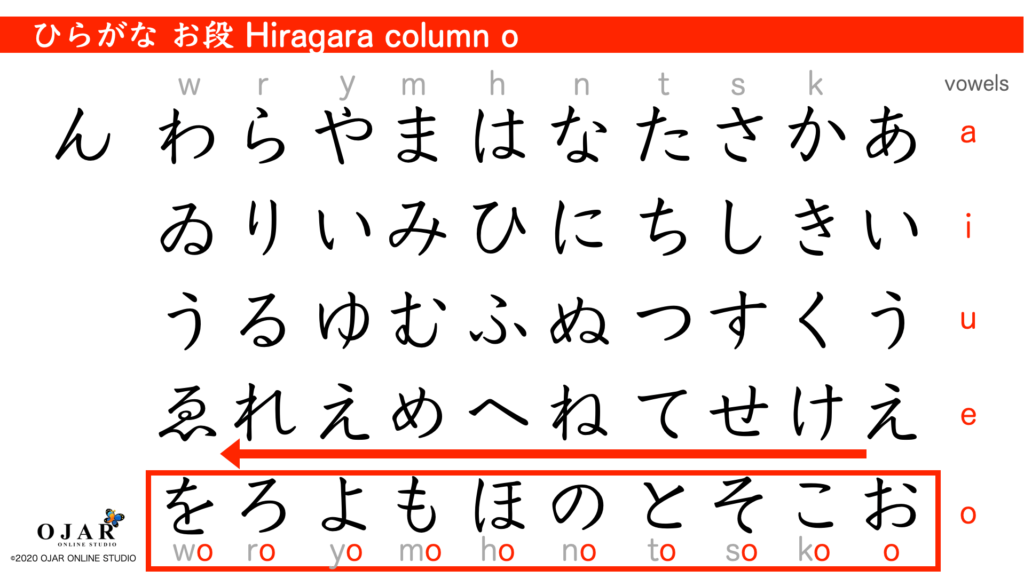
“お段 o-dan” are composed of “o sound” and consonants.
お こ そ と の ほ も よ ろ を
o ko so to no ho mo yo ro wo
Okay, that’s all for today!
Good luck with your Japanese study 😊🍀
THE NEXT LESSON is:
Japanese Lesson 2: How to Say Greetings in Japanese

